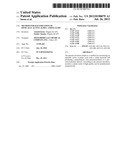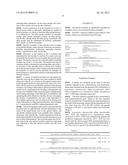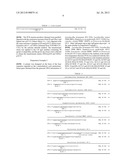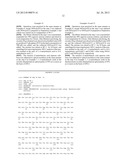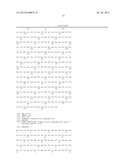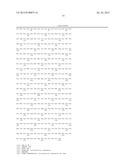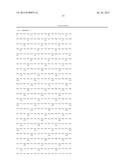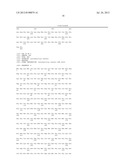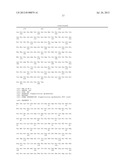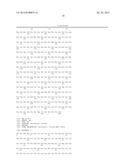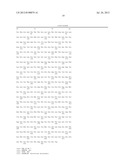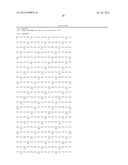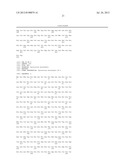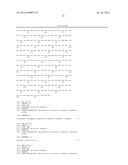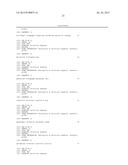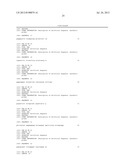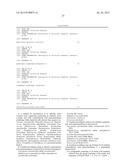Patent application title: METHOD FOR RACEMIZATION OF OPTICALLY ACTIVE ALPHA -AMINO ACIDS
Inventors:
Atsushi Inoue (Niigata-Shi, JP)
Yusuke Tanaka (Niigata-Shi, JP)
Assignees:
Mitsubishi Gas Chemical Company, Inc.
IPC8 Class: AC12P1324FI
USPC Class:
435107
Class name: Micro-organism, tissue cell culture or enzyme using process to synthesize a desired chemical compound or composition preparing alpha or beta amino acid or substituted amino acid or salts thereof proline; hydroxyproline; histidine
Publication date: 2012-07-26
Patent application number: 20120190079
Abstract:
The present invention relates to a method for racemizing an optically
active α-amino acid with a viable bacterial cell producing
γ-aminobutyric acid aminotransferase or a processed product
thereof. According to the present invention, racemic α-amino acids
of high quality can be manufactured inexpensively.Claims:
1. A method for racemization of an optically active α-amino acid,
comprising racemizing an optically active α-amino acid with
γ-aminobutyric acid aminotransferase producing viable bacterial
cells derived from genera Leuconostoc, Lactobacillus, Weissella,
Oenococcus, Staphylococcus, Aminobacterium, Alkaliphilus, Clostridium,
Pyrococcus, Thermococcus, Thermofilum, Pyrobaculum, Anoxybacillus,
Syntrophus, Thermoproteus, Symbiobacterium, Desulfurococcus, Bacillus,
Acidobacteria, Clostridium, Deinococcus, Pelobacter, Geobacillus,
Geobacter, Pelotomaculum, Solibacter, Coprothermobacter, Aeropyrum,
Gloeobacter, Nostoc, Herpetosiphon, Metallosphaera, Syntrophobacter,
Photorhabdus, Caldivirga, Hyperthermus, Thermoplasma, Gemmata, Anabaena,
Cyanothece, Picrophilus or Chloroflexus, or a processed product thereof.
2. A method according to claim 1, wherein γ-aminobutyric acid aminotransferase is derived from bacteria belonging to: Leuconostoc mesenteroides subsp. mesenteroides, Staphylococcus saprophyticus subsp. saprophyticus, Lactobacillus fermentum, Lactobacillus reuteri, Staphylococcus epidermidis, Leuconostoc citreum, or Pyrococcus horikoshii.
3. A method according to claim 1 or 2, wherein γ-aminobutyric acid aminotransferase is derived from: Leuconostoc mesenteroides subsp. mesenteroides ATCC 8293, Staphylococcus saprophyticus subsp. saprophyticus ATCC 15305, Lactobacillus fermentum IFO 3956, Lactobacillus reuteri DSM 20016, Staphylococcus epidermidis ATCC 12228, Leuconostoc citreum NBRC 102476, or Pyrococcus horikoshii OT-3.
4. A method according to any one of claims 1 to 3, wherein γ-aminobutyric acid aminotransferase is a polypeptide selected from: (a) a polypeptide consisting of an amino acid sequence selected from the group consisting of the amino acid sequences of SEQ ID NOS: 1, 2, 3, 4, 5, 6, 7 and 8, (b) a polypeptide consisting of the amino acid sequence in which one or more amino acid residues are deleted, substituted or added in said amino acid sequence of (a), or (c) a polypeptide comprising the amino acid sequence having 75% or higher identity to said amino acid sequence of (a).
5. A method for racemization of optically active α-amino acids, comprising racemizing optically active α-amino acids with γ-aminobutyric acid aminotransferase selected from: (a) a polypeptide consisting of an amino acid sequence selected from the group consisting of the amino acid sequences of SEQ ID NOS: 1, 2, 3, 4, 5, 6, 7 and 8, (b) a polypeptide consisting of the amino acid sequence in which one or more amino acid residues are deleted, substituted or added in said amino acid sequence of (a), or (c) a polypeptide consisting of the amino acid sequence having 75% or higher identity to said amino acid sequence of (a).
6. A method according to any one of claims 1 to 5, wherein γ-aminobutyric acid aminotransferase is a polypeptide derived from Leuconostoc mesenteroides subsp. mesenteroides ATCC 8293 and selected from: (a1) a polypeptide consisting of an amino acid sequence selected from the group consisting of the amino acid sequence of SEQ ID NO: 1, (b1) a polypeptide consisting of the amino acid sequence in which one or more amino acid residues are deleted, substituted or added in said amino acid sequence of (a1), or (c1) a polypeptide consisting of the amino acid sequence having 75% or higher identity to said amino acid sequence of (a1).
7. A method according to any one of claims 1 to 5, wherein γ-aminobutyric acid aminotransferase is a polypeptide derived from Staphylococcus saprophyticus subsp. saprophyticus ATCC 15305 and selected from: (a2) a polypeptide consisting of the amino acid sequence selected from the group consisting of the amino acid sequence of SEQ ID NO: 2, (b2) a polypeptide consisting of the amino acid sequence in which one or more amino acid residues are deleted, substituted or added in said amino acid sequence of (a2), or (c2) a polypeptide consisting of the amino acid sequence having 75% or higher identity to said amino acid sequence of (a2).
8. A method according to any one of claims 1 to 5, wherein γ-aminobutyric acid aminotransferase is a polypeptide derived from Lactobacillus fermentum IFO 3956 and selected from: (a3) a polypeptide consisting of an amino acid sequence selected from the group consisting of the amino acid sequence of SEQ ID NO: 3, (b3) a polypeptide consisting of the amino acid sequence in which one or more amino acid residues are deleted, substituted or added in said amino acid sequence of (a3), or (c3) a polypeptide consisting of the amino acid sequence having 75% or higher identity to said amino acid sequence of (a3).
9. A method according to any one of claims 1 to 5, wherein γ-aminobutyric acid aminotransferase is a polypeptide derived from Lactobacillus reuteri DSM 20016 and selected from: (a4) a polypeptide consisting of an amino acid sequence selected from the group consisting of the amino acid sequence of SEQ ID NO: 4, (b4) a polypeptide consisting of the amino acid sequence in which one or more amino acid residues are deleted, substituted or added in said amino acid sequence of (a4), or (c4) a polypeptide consisting of the amino acid sequence having 75% or higher identity to said amino acid sequence of (a4).
10. A method according to any one of claims 1 to 5, wherein γ-aminobutyric acid aminotransferase is a polypeptide derived from Staphylococcus epidermidis ATCC 12228 and selected from: (a5) a polypeptide consisting of an amino acid sequence selected from the group consisting of the amino acid sequence ID NO: 5, (b5) a polypeptide consisting of the amino acid sequence in which one or more amino acid residues are deleted, substituted or added in said amino acid sequence of (a5), or (c5) a polypeptide consisting of the amino acid sequence having 75% or higher identity to said amino acid sequence of (a5).
11. A method according to any one of claims 1 to 5, wherein γ-aminobutyric acid aminotransferase is a polypeptide derived from Leuconostoc citreum NBRC 102476 and selected from: (a6) a polypeptide consisting of an amino acid sequence selected from the group consisting of the amino acid sequence of SEQ ID NO: 6, (b6) a polypeptide consisting of the amino acid sequence in which one or more amino acid residues are deleted, substituted or added in said amino acid sequence of (a6), or (c6) a polypeptide consisting of the amino acid sequence having 75% or higher identity to said amino acid sequence of (a6).
12. A method according to any one of claims 1 to 5, wherein γ-aminobutyric acid aminotransferase is a polypeptide derived from Pyrococcus horikoshii OT-3 and selected from: (a7) a polypeptide consisting of an amino acid sequence selected from the group consisting of the amino acid sequences of SEQ ID NOS: 7 or 8, (b7) a polypeptide consisting of the amino acid sequence in which one or more amino acid residues are deleted, substituted or added in said amino acid sequence of (a7), or (c7) a polypeptide consisting of the amino acid sequence having 75% or higher identity to said amino acid sequence of (a7).
13. A method according to any one of claims 1 to 12, wherein the optically active α-amino acid comprises one or more of the compounds represented by the following formula (I): ##STR00004## wherein R represents a benzyl group which is optionally substituted by methyl or hydroxy groups, or a linear or branched alkyl group having 1 to 4 carbon atoms, wherein the alkyl group is optionally substituted by hydroxy, methylthio, thiol, amide, or imidazolyl groups.
14. A method according to claim 13, wherein optically active α-amino acid comprises one or more of the compounds selected from the group consisting of alanine, valine, leucine, isoleucine, tert-leucine, histidine, phenylalanine, methionine, asparagine, tyrosine, serine and 2-aminobutyric acid.
15. A method according to any one of claims 1 to 14, wherein the optically active α-amino acid is the L form.
16. A method according to any one of claims 1 to 14, wherein the optically active α-amino acid is the D form.
Description:
CROSS-REFERENCE TO RELATED APPLICATION
[0001] This application is based upon and claims the benefit of priority from the prior Japanese Patent Application No. 2009-154287, filed on Jun. 29, 2009, the entire contents of which are incorporated herein by reference.
BACKGROUND OF THE INVENTION
[0002] 1. Field of the Invention
[0003] The present invention relates to the method for racemization of optically active α(alpha)-amino acids.
[0004] 2. Related Art
[0005] In the course of manufacturing optically active D- or L-α-amino acids utilized as the intermediate for manufacturing a variety of industrial agents, agricultural agents and medicines by using an optical resolution agent, the racemization of the other remaining optically active D- or L-α-amino acid into a racemic α-amino acid as a raw material again is an important method.
[0006] As a method for racemizing an optically active α-amino acid, chemical racemization methods are known such as the methods for racemizing an α-amino acid at high temperature in an acidic or alkaline aqueous solution (U.S. Pat. Nos. 2,586,154 and 4,769,486). However, these methods use severe reaction conditions resulting in many by-products. Racemization methods with catalysts are also known such as the methods for racemization with salicylaldehyde as an catalyst under the acidic conditions (Japanese Patent Laid-Open Publication H11-228512 and H11-322684 (European Patent corresponding to the previous two Japanese Patent Laid-Open Publications being EP 0937705A)). However, these methods also have severe reaction conditions thus giving the α-amino acid with decreased yields.
[0007] The racemization methods with enzymes are also known as the method for racemizing an optically active α-amino acid. In general, enzymes such as alanine racemase, glutamate racemase and proline racemase racemize amino acids. However, these enzymes generally have a high substrate specificity and are unsuited for manufacturing the racemic α-amino acid from a variety of optically active α-amino acids.
[0008] As the enzymes for racemizing optically active α-amino acids, amino acid racemases having low substrate specificity are also known (International Publication No. 2003/074690, (Kenji Soda, Sei-kagaku Jikken Koza 11: Metabolism of amino acids, and biogenic amines (I), Tokyo Kagaku Dojin, P. 275-296 (1976))). However, said enzymes exhibits only the low activity to optically active aliphatic α-amino acids and are hardly applied to the racemization of a variety of optically active α-amino acid.
[0009] As the other methods, there is also known the method for racemization of α-amino acids with microorganisms (Japanese Patent Laid-Open Publication No. 2004-57014). However, the microorganisms disclosed herein have only racemization activity to aromatic α-amino acids and thus are hardly applied to the racemization of a variety of optically active α-amino acid as described above.
[0010] While several methods for racemizing the optically active α-amino acids are known as described above, all of these methods have some problems. Therefore, an efficient racemization method which can be applied to a variety of optically active α-amino acids has still been demanded.
SUMMARY OF THE INVENTION
[0011] The present inventors have now unexpectedly found that an enzyme classified to γ(gamma)-aminobutyric acid aminotransferase which is originally involved in the reaction of γ-aminobutyric acid and 2-oxoglutaric acid has an activity for racemizing a wide variety of optically active α-amino acids. The present invention is based on such findings.
[0012] The object of the present invention is to provide a method for inexpensively manufacturing a racemic α-amino acid of high quality in the course of manufacturing an optically active D- or L-α-amino acid utilized as the intermediate for manufacturing a variety of industrial agents, agricultural agents and medicines by using an optical resolution agent which may be further used as a raw material from the other remaining optically active D- or L-α-amino acid. It will be possible to further obtain the desired optically active α-amino acid in a high yield from the racemic α-amino acid thus obtained as the raw material.
[0013] That is, the following inventions are provided according to the present invention:
(1) A method for racemization of an optically active α-amino acid, comprising racemizing an optically active α-amino acid with γ-aminobutyric acid aminotransferase producing viable bacterial cells derived from genera Leuconostoc, Lactobacillus, Weissella, Oenococcus, Staphylococcus, Aminobacterium, Alkaliphilus, Clostridium, Pyrococcus, Thermococcus, Thermofilum, Pyrobaculum, Anoxybacillus, Syntrophus, Thermoproteus, Symbiobacterium, Desulfurococcus, Bacillus, Acidobacteria, Clostridium, Deinococcus, Pelobacter, Geobacillus, Geobacter, Pelotomaculum, Solibacter, Coprothermobacter, Aeropyrum, Gloeobacter, Nostoc, Herpetosiphon, Metallosphaera, Syntrophobacter, Photorhabdus, Caldivirga, Hyperthermus, Thermoplasma, Gemmata, Anabaena, Cyanothece, Picrophilus or Chloroflexus, or a processed product thereof. (2) A method according to (1), wherein γ-aminobutyric acid aminotransferase is derived from bacteria belonging to: [0014] Leuconostoc mesenteroides subsp. mesenteroides, Staphylococcus saprophyticus subsp. saprophyticus, [0015] Lactobacillus fermentum, [0016] Lactobacillus reuteri, [0017] Staphylococcus epidermidis, [0018] Leuconostoc citreum, or [0019] Pyrococcus horikoshii. (3) A method according to (1) or (2), wherein γ-aminobutyric acid aminotransferase is derived from: [0020] Leuconostoc mesenteroides subsp. mesenteroides ATCC 8293, Staphylococcus saprophyticus subsp. saprophyticus ATCC 15305, [0021] Lactobacillus fermentum IFO 3956, [0022] Lactobacillus reuteri DSM 20016, [0023] Staphylococcus epidermidis ATCC 12228, [0024] Leuconostoc citreum NBRC 102476, or [0025] Pyrococcus horikoshii OT-3. (4) A method according to any one of (1) to (3), wherein γ-aminobutyric acid aminotransferase is a polypeptide selected from: [0026] (a) a polypeptide consisting of an amino acid sequence selected from the group consisting of the amino acid sequences of SEQ ID NOS: 1, 2, 3, 4, 5, 6, 7 and 8, [0027] (b) a polypeptide consisting of the amino acid sequence in which one or more amino acid residues are deleted, substituted or added in said amino acid sequence of (a), or [0028] (c) a polypeptide consisting of the amino acid sequence having 75% or higher identity to said amino acid sequence of (a). (5) A method for racemization of optically active α-amino acids, comprising racemizing optically active α-amino acids with γ-aminobutyric acid aminotransferase selected from: [0029] (a) a polypeptide consisting of an amino acid sequence selected from the group consisting of the amino acid sequences of SEQ ID NOS: 1, 2, 3, 4, 5, 6, 7 and 8, [0030] (b) a polypeptide consisting of the amino acid sequence in which one or more amino acid residues are deleted, substituted or added in said amino acid sequence of (a), or [0031] (c) a polypeptide consisting of the amino acid sequence having 75% or higher identity to said amino acid sequence of (a). (6) A method according to any one of (1) to (5), wherein γ-aminobutyric acid aminotransferase is a polypeptide derived from Leuconostoc mesenteroides subsp. mesenteroides ATCC 8293 and selected from: [0032] (a1) a polypeptide consisting of an amino acid sequence selected from the group consisting of the amino acid sequence of SEQ ID NO: 1, [0033] (b1) a polypeptide consisting of the amino acid sequence in which one or more amino acid residues are deleted, substituted or added in said amino acid sequence of (a1), or [0034] (c1) a polypeptide consisting of the amino acid sequence having 75% or higher identity to said amino acid sequence of (a1). (7) A method according to any one of (1) to (5), wherein γ-aminobutyric acid aminotransferase is a polypeptide derived from Staphylococcus saprophyticus subsp. saprophyticus ATCC 15305 and selected from: [0035] (a2) a polypeptide consisting of an amino acid sequence selected from the group consisting of the amino acid sequence of SEQ ID NO: 2, [0036] (b2) a polypeptide consisting of the amino acid sequence in which one or more amino acid residues are deleted, substituted or added in said amino acid sequence of (a2), or [0037] (c2) a polypeptide consisting of the amino acid sequence having 75% or higher identity to said amino acid sequence of (a2). (8) A method according to any one of (1) to (5), wherein γ-aminobutyric acid aminotransferase is a polypeptide derived from Lactobacillus fermentum IFO 3956 and selected from: [0038] (a3) a polypeptide consisting of an amino acid sequence selected from the group consisting of the amino acid sequence of SEQ ID NO: 3, [0039] (b3) a polypeptide consisting of the amino acid sequence in which one or more amino acid residues are deleted, substituted or added in said amino acid sequence of (a3), or [0040] (c3) a polypeptide consisting of the amino acid sequence having 75% or higher identity to said amino acid sequence of (a3). (9) A method according to any one of (1) to (5), wherein γ-aminobutyric acid aminotransferase is a polypeptide derived from Lactobacillus reuteri DSM 20016 and selected from: (a4) a polypeptide consisting of an amino acid sequence selected from the group consisting of the amino acid sequence of SEQ ID NO: 4, [0041] (b4) a polypeptide consisting of the amino acid sequence in which one or more amino acid residues are deleted, substituted or added in said amino acid sequence of (a4), or [0042] (c4) a polypeptide consisting of the amino acid sequence having 75% or higher identity to said amino acid sequence of (a4). (10) A method according to any one of (1) to (5), wherein γ-aminobutyric acid aminotransferase is a polypeptide derived from Staphylococcus epidermidis ATCC 12228 and selected from: [0043] (a5) a polypeptide consisting of an amino acid sequence selected from the group consisting of the amino acid sequence of SEQ ID NO: 5, [0044] (b5) a polypeptide consisting of the amino acid sequence in which one or more amino acid residues are deleted, substituted or added in said amino acid sequence of (a5), or [0045] (c5) a polypeptide consisting of the amino acid sequence having 75% or higher identity to said amino acid sequence of (a5). (11) A method according to any one of (1) to (5), wherein γ-aminobutyric acid aminotransferase is a polypeptide derived from Leuconostoc citreum NBRC 102476 and selected from: [0046] (a6) a polypeptide consisting of an amino acid sequence selected from the group consisting of the amino acid sequence of SEQ ID NO: 6, [0047] (b6) a polypeptide consisting of the amino acid sequence in which one or more amino acid residues are deleted, substituted or added in said amino acid sequence of (a6), or [0048] (c6) a polypeptide consisting of the amino acid sequence having 75% or higher identity to said amino acid sequence of (a6). (12) A method according to any one of (1) to (5), wherein γ-aminobutyric acid aminotransferase is a polypeptide derived from Pyrococcus horikoshii OT-3 and selected from: [0049] (a7) a polypeptide consisting of an amino acid sequence selected from the group consisting of the amino acid sequences of SEQ ID NOS: 7 or 8, [0050] (b7) a polypeptide consisting of the amino acid sequence in which one or more amino acid residues are deleted, substituted or added in said amino acid sequence of (a7), or [0051] (c7) a polypeptide consisting of the amino acid sequence having 75% or higher identity to said amino acid sequence of (a7). (13) A method according to any one of (1) to (12), wherein the optically active α-amino acid comprises one or more of the compounds represented by the following formula (I):
##STR00001##
[0051] wherein R represents [0052] a benzyl group which is optionally substituted by methyl or hydroxy groups, or [0053] a linear or branched alkyl group having 1 to 4 carbon atoms, wherein the alkyl group is optionally substituted by hydroxy, methylthio, thiol, amide, or imidazolyl groups. (14) A method according to (13), wherein optically active α-amino acid comprises one or more of the compounds selected from the group consisting of alanine, valine, leucine, isoleucine, tert-leucine, histidine, phenylalanine, methionine, asparagine, tyrosine, serine and 2-aminobutyric acid. (15) A method according to any one of (1) to (14), wherein the optically active α-amino acid is the L form. (16) A method according to any one of (1) to (14), wherein the optically active α-amino acid is the D form.
[0054] Moreover, according to another embodiment of the present invention, the following inventions are provided:
(2') A method for racemization of optically active α-amino acids according to (1), wherein the γ-aminobutyric acid aminotransferase is an amino acid sequence derived from Leuconostoc mesenteroides subsp. mesenteroides ATCC 8293, represented by SEQ ID NO: 1, or an amino acid sequence in which one or more amino acid residues have been deleted, substituted or added from the amino acid sequence of SEQ ID NO: 1. (3') A method for racemization of optically active α-amino acids according to (1), wherein the γ-aminobutyric acid aminotransferase is derived from Staphylococcus saprophyticus subsp. saprophyticus ATCC 15305, represented by SEQ ID NO: 2, or an amino acid sequence in which one or more amino acid residues have been deleted, substituted or added from the amino acid sequence of SEQ ID NO: 2. (4') A method for racemization of optically active α-amino acids according to (1), wherein the γ-aminobutyric acid aminotransferase is derived from Lactobacillus fermentum IFO 3956, represented by SEQ ID NO: 3, or an amino acid sequence in which one or more amino acid residues have been deleted, substituted or added from the amino acid sequence of SEQ ID NO: 3. (5') A method for racemization of optically active α-amino acids according to (1), wherein the γ-aminobutyric acid aminotransferase is derived from Lactobacillus reuteri DSM 20016, represented by SEQ ID NO: 4, or an amino acid sequence in which one or more amino acid residues have been deleted, substituted or added from the amino acid sequence of SEQ ID NO: 4. (6') A method for racemization of optically active α-amino acids according to (1), wherein the γ-aminobutyric acid aminotransferase is derived from Staphylococcus epidermidis ATCC 12228, represented by SEQ ID NO: 5, or an amino acid sequence in which one or more amino acid residues have been deleted, substituted or added from the amino acid sequence of SEQ ID NO: 5. (7') A method for racemization of optically active α-amino acids according to (1), wherein the γ-aminobutyric acid aminotransferase is derived from Leuconostoc citreum NBRC 102476, represented by SEQ ID NO: 6, or an amino acid sequence in which one or more amino acid residues have been deleted, substituted or added from the amino acid sequence of SEQ ID NO: 6. (8') A method for racemization of optically active α-amino acids according to (1), wherein the γ-aminobutyric acid aminotransferase is derived from Pyrococcus horikoshii OT-3, represented by SEQ ID NOS: 7 or 8, or an amino acid sequence in which one or more amino acid residues have been deleted, substituted or added from the amino acid sequence of SEQ ID NOS: 7 or 8. (9') A method for racemization of optically active α-amino acids according to (1), wherein the γ-aminobutyric acid aminotransferase producing bacterial cell or a processed product thereof is represented by SEQ ID NOS: 1, 2, 3, 4, 5, 6, 7 or 8, or a gene recombinant bacterium modified in such a manner that γ-aminobutyric acid aminotransferase which is an amino acid sequence in which one or more amino acid residues have been deleted, substituted or added from the amino acid sequence of SEQ ID NOS: 1, 2, 3, 4, 5, 6, 7 or 8 is produced, or a processed product thereof. (10') A method for racemization of optically active α-amino acids according to any one of (1) to (9'), wherein the optically active α-amino acid is at least one selected from alanine, valine, leucine, phenylalanine, methionine, serine and 2-aminobutyric acid.
[0055] In the present invention, the racemization of an optically active α-amino acid can be performed without processes such as the derivatization of α-amino acids by using γ-aminobutyric acid aminotransferase producing viable bacterial cells which have the racemization activity of α-amino acids, or a processed product thereof. According to the present invention, a variety of optically active α-amino acids of high quality which are useful as the intermediate for manufacturing a variety of industrial agents, agricultural agents and medicines can be racemized efficiently and inexpensively. The other L- or D-α-amino acid hitherto remaining after the optical resolution of an racemic α-amino acid can be effectively used as the raw material to give the desired optically active amino acid and thus very useful in the fields of medicine, agricultural agents and the like.
DETAILED DESCRIPTION OF THE INVENTION
γ-Aminobutyric Acid Aminotransferase The γ-aminobutyric acid aminotransferase used in the present invention has the racemization activity of optically active α-amino acids.
[0056] Herein, the phraseology "has the racemization activity of optically active α-amino acids" means to racemize an optically active α-amino acid, that is, the α-amino acid consisting of only one of the L- or D-isomer or the mixture of the L- and D-isomers of which the abundance ratio is biased to any one of the forms, and whether the intended enzyme (or polypeptide) has such racemization activity or not may be measured according to the conventional methods including those described later in examples (Examples 1 to 5), by which the activity can be confirmed. As regards the confirmation of having the racemization activity or not, further specifically the desired enzyme used according to the description of the examples can be judged active if the ratio of the L- and D-isomers is varied after the reaction with the L- or D-isomer of the α-amino acid as the substrate. The variation in this case is the one that the optical activity decreases. Even if the variation in the ratio of the L- and D-isomers is confirmed little, the variation range can be changed by changing the amounts of bacterial cells and enzyme.
[0057] In the present invention, the γ-aminobutyric acid aminotransferase is typically derived from genera Leuconostoc, Lactobacillus, Weissella, Oenococcus, Staphylococcus, Aminobacterium, Alkaliphilus, Clostridium, Pyrococcus, Thermococcus, Thermofilum, Pyrobaculum, Anoxybacillus, Syntrophus, Thermoproteus, Symbiobacterium, Desulfurococcus, Bacillus, Acidobacteria, Clostridium, Deinococcus, Pelobacter, Geobacillus, Geobacter, Pelotomaculum, Solibacter, Coprothermobacter, Aeropyrum, Gloeobacter, Nostoc, Herpetosiphon, Metallosphaera, Syntrophobacter, Photorhabdus, Caldivirga, Hyperthermus, Thermoplasma, Gemmata, Anabaena, Cyanothece, Picrophilus or Chloroflexus.
[0058] Preferably, said γ-aminobutyric acid aminotransferase is derived from genera Leuconostoc, Lactobacillus, Weissella, Oenococcus, Staphylococcus, Aminobacterium, Alkaliphilus, Clostridium, Pyrococcus, Thermococcus or Thermofilum, and more preferably, from genera Leuconostoc, Lactobacillus, Oenococcus, Staphylococcus, Aminobacterium, Alkaliphilus, Clostridium or Pyrococcus.
[0059] According to the further preferred embodiment of the present invention, the γ-aminobutyric acid aminotransferase is derived from: [0060] Leuconostoc mesenteroides subsp. mesenteroides, [0061] Staphylococcus saprophyticus subsp. saprophyticus, [0062] Lactobacillus fermentum, [0063] Lactobacillus reuteri, [0064] Staphylococcus epidermidis, [0065] Leuconostoc citreum, or [0066] Pyrococcus horikoshii, and more preferably [0067] Leuconostoc mesenteroides subsp. mesenteroides ATCC 8293, [0068] Staphylococcus saprophyticus subsp. saprophyticus ATCC 15305, [0069] Lactobacillus fermentum IFO 3956, [0070] Lactobacillus reuteri DSM 20016, [0071] Staphylococcus epidermidis ATCC 12228, [0072] Leuconostoc citreum NBRC 102476, or [0073] Pyrococcus horikoshii OT-3.
[0074] The γ-aminobutyric acid aminotransferase in the present invention is a polypeptide selected from: [0075] (a) a polypeptide composed of an amino acid sequence selected from the group consisting of the amino acid sequences of SEQ ID NOS: 1, 2, 3, 4, 5, 6, 7 and 8, [0076] (b) a polypeptide consisting of the amino acid sequence in which one or more amino acid residues are deleted, substituted or added in said amino acid sequence of (a), or [0077] (c) a polypeptide consisting of the amino acid sequence having 75% or higher identity to said amino acid sequence of (a).
[0078] The polypeptide (b) described above (referred to hereinafter as "modified polypeptide") comprises any one of the amino acid sequences selected from the group consisting of the amino acid sequences of SEQ ID NOS: 1, 2, 3, 4, 5, 6, 7 and 8 in which one or more amino acid residues have been deleted, substituted or added. In this context, the number of the amino acids which may be deleted, substituted or added is, for example, in the range of 1 to 40, preferably 1 to 30, more preferably 1 to 20, further preferably 1 to 10, particularly preferably 1 to 8, most preferably 1 to 4.
[0079] The term "deleted" (or lost) also includes polypeptides that amino acid residues have been lost from the terminal of an amino acid sequence and that amino acid residues have been deleted in the middle of an amino acid sequence.
[0080] Furthermore, the term "added" also includes polypeptides that amino acid residues have been added to the terminal of an amino acid sequence and that amino acid residues have been added (inserted) to the middle of an amino acid sequence.
[0081] The modified polypeptide described in (b) may be a polypeptide comprising any one of the amino acid sequences selected from the group consisting of the amino acid sequences of SEQ ID NOS: 1, 2, 3, 4, 5, 6, 7 and 8 in which one or more amino acid residues have been conservatively substituted and having the racemization activity of optically active α-amino acids.
[0082] In this context, the term "conservatively substituted" means the substitution of one or more (preferably several) amino acid residues by the other chemical analogous amino acid residues so that the activity of the peptide will not substantially be modified. For instance, such substitutions include the substitutions of a hydrophobic residue by the other hydrophobic residue or of a polar residue by the other polar residue having the same charge. Functionally similar amino acids which can perform such substitutions are well known in the art with every amino acid. By way of specific examples, nonpolar (hydrophobic) amino acids include alanine, valine, isoleucine, leucine, proline, tryptophan, phenylalanine, methionine, and the like. Polar (neutral) amino acids include glycine, serine, threonine, tyrosine, glutamine, asparagine, cysteine, and the like. (Basic) amino acids having a positive charge include arginine, histidine, lysine, and the like. In addition, (acidic) amino acids having a negative charge include aspartic acid, glutamic acid, and the like.
[0083] In this connection, the modification of the amino acid by deletion, substitution or addition can be performed, for example, by subjecting DNA coding for the modification to site-specific mutagenesis as the well-known technique (see, for example, Nucleic Acid Research, Vol. 10, No. 20, p. 6487-6500, 1982). The other methods include a method for treating genes with mutagens, a method for selectively cleaving genes, followed by removing, adding and/or substituting the selected nucleotides, which are linked together, and the like.
[0084] The polypeptide (c) described above (referred to hereinafter as homologous polypeptide) is not specifically restricted as far as it is composed of the amino acid sequence having 75% or higher identity to an amino acid sequence selected from the group consisting of the amino acid sequences of SEQ ID NOS: 1, 2, 3, 4, 5, 6, 7 and 8, that is, the amino acid sequence of γ-aminobutyric acid aminotransferase. The "identity" is preferably in the range of 80% or more, more preferably 85% or more, further preferably 90% or more, further more preferably 95% or more, particularly preferably 98% or more, and most preferably 99% or more. The homologous polypeptide in (c) has the activity for racemizing the optically active α-amino acids as well as the polypeptide in (a).
[0085] In this specification, all of the values of the "identity" may only be values calculated with the homology retrieval program well known to persons in the art and may be calculated, for example, with a default parameter in the homology algorithm BLAST (Basic local alignment search tool) of the National Center for Biotechnology Information (NCBI)(http://www.ncbi.nlm.nih.gov/BLAST/).
[0086] The γ-aminobutyric acid aminotransferase in the present invention is preferably any one of the following (I) to (VII):
(I) a polypeptide derived from Leuconostoc mesenteroides subsp. mesenteroides ATCC 8293 and selected from: [0087] (a1) a polypeptide consisting of an amino acid sequence selected from the group consisting of the amino acid sequence of SEQ ID NO: 1 [0088] (b1) a polypeptide consisting of the amino acid sequence in which one or more amino acid residues are deleted, substituted or added in said amino acid sequence of (a1), or [0089] (c1) a polypeptide consisting of the amino acid sequence having 75% or higher identity to said amino acid sequence of (a1); (II) a polypeptide derived from Staphylococcus saprophyticus subsp. saprophyticus ATCC 15305 and selected from: [0090] (a2) a polypeptide consisting of an amino acid sequence selected from the group consisting of the amino acid sequence of SEQ ID NO: 2, [0091] (b2) a polypeptide consisting of the amino acid sequence in which one or more amino acid residues are deleted, substituted or added in said amino acid sequence of (a2), or [0092] (c2) a polypeptide consisting of the amino acid sequence having 75% or higher identity to said amino acid sequence of (a2); (III) a polypeptide derived from Lactobacillus fermentum IFO 3956 and selected from: [0093] (a3) a polypeptide consisting of an amino acid sequence selected from the group consisting of the amino acid sequence of SEQ ID NO: 3, [0094] (b3) a polypeptide consisting of the amino acid sequence in which one or more amino acid residues are deleted, substituted or added in said amino acid sequence of (a3), or [0095] (c3) a polypeptide consisting of the amino acid sequence having 75% or higher identity to said amino acid sequence of (a3); (IV) a polypeptide derived from Lactobacillus reuteri DSM 20016 and selected from: [0096] (a4) a polypeptide consisting of an amino acid sequence selected from the group consisting of the amino acid sequence of SEQ ID NO: 4, [0097] (b4) a polypeptide consisting of the amino acid sequence in which one or more amino acid residues are deleted, substituted or added in said amino acid sequence of (a4), or [0098] (c4) a polypeptide consisting of the amino acid sequence having 75% or higher identity to said amino acid sequence of (a4); or (V) a polypeptide derived from Staphylococcus epidermidis ATCC 12228 and selected from: [0099] (a5) a polypeptide consisting of an amino acid sequence selected from the group consisting of the amino acid sequence of SEQ ID NO: 5, [0100] (b5) a polypeptide consisting of the amino acid sequence in which one or more amino acid residues are deleted, substituted or added in said amino acid sequence of (a5), or [0101] (c5) a polypeptide consisting of the amino acid sequence having 75% or higher identity to said amino acid sequence of (a5); or (VI) a polypeptide derived from Leuconostoc citreum NBRC 102476 and selected from: [0102] (a6) a polypeptide consisting of an amino acid sequence selected from the group consisting of the amino acid sequence of SEQ ID NO: 6, [0103] (b6) a polypeptide consisting of the amino acid sequence in which one or more amino acid residues are deleted, substituted or added in said amino acid sequence of (a6), or [0104] (c6) a polypeptide consisting of an amino acid sequence having 75% or higher identity to said amino acid sequence of (a6); or (VII) a polypeptide derived from Pyrococcus horikoshii OT-3 and selected from: [0105] (a7) a polypeptide consisting of an amino acid sequence selected from the group consisting of the amino acid sequence of SEQ ID NO: 7, [0106] (b7) a polypeptide consisting of the amino acid sequence in which one or more amino acid residues are deleted, substituted or added in said amino acid sequence of (a7), or [0107] (c7) a polypeptide consisting of the amino acid sequence having 75% or higher identity to said amino acid sequence of (a7).
[0108] In this connection, the polypeptides in (b1) to (b7) and (c1) to (c7) have the activity for racemizing the optically active α-amino acids, and the number of the amino acids which may be deleted, substituted or added and the percentage of the identity can be confirmed according to (b) and (c).
Method for Racemization of Optically Active α-Amino Acids
[0109] The method for racemization of optically active α-amino acids of the present invention comprises the racemization of an optically active α-amino acid with a viable bacterial cell producing the γ-aminobutyric acid aminotransferase described above or a processed product thereof.
[0110] The microorganisms used for the biochemical racemization of the optically active α-amino acid of the present invention may only be the microorganisms which produce γ-aminobutyric acid aminotransferase having the racemization activity of an α-amino acid. In addition, all of the strains including mutant strains derived from these microorganisms by an artificial mutation means or recombinant strains derived by the genetic technologies such as cell fusion or gene recombination may be used in the present invention provided that these strains have the ability described above. In the present invention, genetic recombinant bacteria which have been modified so that the γ-aminobutyric acid aminotransferase described above is produced can be used suitably.
[0111] More particularly, the microorganisms producing the γ-aminobutyric acid aminotransferase can be obtained by the gene recombination of DNA coding for the γ-aminobutyric acid aminotransferase according to the method described in Molecular Cloning, 3rd Ed. (ed. Sambrook J. and Russell D. W.), Cold Spring Harbor, N.Y., 2001).
[0112] That is, the recombinant DNA is prepared by inserting the desired structural gene downstream the promoter of an appropriate vector. A transformant producing the γ-aminobutyric acid aminotransferase in the present invention can be obtained by introducing the recombinant DNA into host cells adapted to the expression vector.
[0113] As the host cells, any cell which can express the aimed gene including bacteria, actinomycetes, yeast, animal cells, insect cells, plant cells, and the like can be used. Preferably, there are mentioned bacteria including colon bacillus such as Escherichia coli, actinomycetes such as Streptomyces, and the like.
[0114] As the recombinant DNA, there is used the one which can self-replicate or can be integrated into chromosome in the host cells and has a promoter at the position in which the DNA of the present invention can be transcribed.
[0115] When prokaryotes such as bacteria are used as the host cells, the recombinant DNA comprising a DNA which codes for the protein of the present invention is preferably a recombinant DNA which can self-replicate in the prokaryote and is composed of a promoter, a ribosome binding sequence, the DNA of the present invention and a transcription terminating sequence. Furthermore, a gene controlling the promoter may be contained in the recombinant DNA.
[0116] The expression vector which can be used includes, for example, pTA2 (Toyobo Co., Ltd.), Helix 1 (Roche Diagnostics), pKK233-2 (Amersham Pharmacia Biotech), pSE280 (Invitrogen), pGEMEX-1 (Promega), pQE-8 (Quiagen), pET24 (Novagen), pBluescript II SK(+), pBluescript II SK(-) (Stratagene), pUC19 [Gene, 33, 103 (1985)], pSTV28 (Takara Shuzo Co., Ltd.), pUC118 (Takara Shuzo Co., Ltd.), p136902 [Mol. Microbiol., 58, 1276 (2005)], pSET152 [3. Mol. Microbiol., 4, 417 (2002)], and the like.
[0117] As the promoter, any promoter which can work in the host cells can be used without particular limitation, and includes, for example, E. coli or phage derived promoters such as the trp promoter (Ptrp), the lac promoter (Plac), the T7 promoter, the PL promoter, the PR promoter, the PSE promoter, and the like.
[0118] The prokaryote as the host cells includes microorganisms belonging to genera Escherichia, Serratia, Bacillus, Brevibacterium, Corynebacterium, Microbacterium, Streptomyces and the like.
[0119] As the specific example, the method for preparing the E. coli DH5α strain newly prepared by the present inventors and having the ability for expressing γ-aminobutyric acid aminotransferase represented by SEQ ID NO: 1 or 2 is described below.
[0120] Leuconostoc mesenteroides subsp. mesenteroides ATCC 8293 or Staphylococcus saprophyticus subsp. saprophyticus ATCC 15305 as the DNA donor microorganism is cultured with a medium which generally contains assimilable carbon sources, nitrogen sources, inorganic salts essential to each microorganism, nutrients, and the like. The microorganism was cultured preferably at pH in the range of 4 to 10 and at a temperature in the range of 20 to 50° C. Culture is aerobically conducted for about 1 day to 1 week.
[0121] In this connection, the condition for culturing microorganism to be cultured (medium composition, pH of medium, culturing temperature, the amount of bacterial cells seeded on the medium, culturing period, and the like) can be appropriately determined on the basis of the literatures corresponding to microbial species and the information shown in the culture collections and depositories.
[0122] A primer is designed on the basis of the genomic DNA base sequence information of Leuconostoc mesenteroides subsp. mesenteroides ATCC 8293 or Staphylococcus saprophyticus subsp. saprophyticus ATCC 15305. DNA coding for γ-aminobutyric acid aminotransferase is amplified with the chromosomal DNA extracted from Leuconostoc mesenteroides subsp. mesenteroides ATCC 8293 or Staphylococcus saprophyticus subsp. saprophyticus ATCC 15305 as the template and bonded with the plasmid vector pUC19. The product is named pAT8 with respect to the former template and pAT15 with respect to the latter template. pAT8 or pAT15 was transformed into E. coli (DH5α), and the recombinant bacteria expressing γ-aminobutyric acid aminotransferase are named DH5α/pAT8 and DH5α/pAT15.
[0123] General operations required for the handling of E. coli as the host of the recombinants are the ones usually practiced in the art and can be carried out, for example, according to Molecular Cloning, 3rd Ed. Moreover, all of the enzymes and reagents to be used may be commercial products, and the object can be completely accomplished according to the working conditions of the products unless otherwise stated. The extraction of whole DNA from the bacteria can be performed, for example, according to the method of Saito et al. (Biochim. Biophys. Acta., 72, 619-629, 1963).
[0124] The microorganism producing the γ-aminobutyric acid aminotransferase may be appropriately cultured under the culture condition corresponding to the bacteria used without particular limitations, since each bacterium has its own optimal growth condition. For instance, the recombinant bacteria, of which host is E. coli DH5α, generally have the appropriate culture condition of pH 7 and the temperature of 37° C. The microorganism thus cultured is used for reactions as the viable bacterial cell or the processed product thereof or as the purified enzyme.
[0125] In this connection, the processed product includes, for example, a culture fluid (culture), a culture concentrate, a dry culture, bacterial cells obtained by centrifuging the culture (separated bacterial cells), dry bacterial cells, lyophilized bacterial cells, surfactant processed bacterial cells, bacterial cell debris such as ultrasonic wave processed bacterial cells and mechanically ground product of the bacterial cells), solvent processed bacterial cells, enzyme processed bacterial cells, a protein fractionated product of the bacterial cells, or an enzyme preparation obtained by extracting from the bacterial cells. Moreover, the bacterial cells or the enzymes may be used by fixation.
[0126] The method for purifying the desired polypeptide from the culture (expressed cells or supernatant of culture) includes, for example, salting out with ammonium sulfate, ion exchange column chromatography with ion exchange cellulose, molecular sieve column chromatography with molecular sieve gel, affinity column chromatography with protein A linked polysaccharide, dialysis or lyophilization. Furthermore, when a synthetic method is used, the polypeptide can be synthesized according to the conventional methods such as liquid phase or solid phase method and an automatic synthesizer may generally be used. Chemically modified products can be synthesized by the conventional methods.
[0127] The optically active α-amino acid subjected to the racemization reaction may be any one of the D- or L-isomer or the mixture of the L- and D-isomers of which the abundance ratio is biased to any one of the forms and specifically includes alanine, glutamine, glutamic acid, valine, leucine, isoleucine, tert-leucine, norvaline, norleucine, proline, phenylalanine, tryptophan, methionine, serine, threonine, cysteine, asparagine, tyrosine, lysine, arginine, histidine, aspartic acid, 2-aminobutyric acid, ornithine, and the like. These amino acids may be a combination of the two or more.
[0128] The optically active α-amino acid subjected to the racemization reaction as the raw material can also be represented by the following formula (I):
##STR00002##
wherein R represents [0129] a benzyl group which is optionally substituted by methyl or hydroxy groups, or [0130] a linear or branched alkyl group having 1 to 4 carbon atoms, wherein the alkyl group is optionally substituted by hydroxy (--OH), methylthio (--S--CH3), thiol (--SH), amide (--C(═O)--NH2), or imidazolyl groups.
[0131] The optically active α-amino acid subjected to the racemization reaction as the raw material is preferably selected from the group consisting of alanine, valine, leucine, isoleucine, norvaline, norleucine, tert-leucine, phenylalanine, tyrosine, methionine, serine, threonine, asparagine, glutamine, histidine, proline, 2-aminobutyric acid and ornithine, more preferably from the group consisting of alanine, valine, leucine, isoleucine, norvaline, norleucine, tert-leucine, phenylalanine, tyrosine, methionine, serine, asparagine, glutamine, histidine, 2-aminobutyric acid and ornithine, further preferably from the group consisting of alanine, valine, leucine, isoleucine, tert-leucine, asparagine, histidine, phenylalanine, methionine, asparagine, tyrosine, serine and 2-aminobutyric acid, further more preferably from the group consisting of alanine, valine, leucine, phenylalanine, methionine, serine and 2-aminobutyric acid. These amino acids may be the ones obtained either chemically or biologically and may contain impurities, but it is preferred to use a purified one.
[0132] Thus, according to another embodiment of the present invention, there is provided a method for racemization of optically active α-amino acids, comprising racemizing optically active α-amino acids with γ-aminobutyric acid aminotransferase selected from: [0133] (a) a polypeptide composed of an amino acid sequence selected from the group consisting of the amino acid sequences of SEQ ID NOS: 1, 2, 3, 4, 5, 6, 7 and 8, [0134] (b) a polypeptide consisting of the amino acid sequence in which one or more amino acid residues are deleted, substituted or added in said amino acid sequence of (a), or [0135] (c) a polypeptide consisting of the amino acid sequence having 75% or higher identity to said amino acid sequence of (a).
[0136] In the present invention, the racemization reaction is carried out in an aqueous solution with the concentration of the α-amino acid in the range of 0.1% by weight--saturated concentration and the amount of the enzyme preferably in the range of 0.00001 to 3 times to the weight of α-amino acid as the raw material, more preferably 0.002 to 0.5 times as the basis of dry bacterial cells containing the enzyme. The reaction temperature is preferably in the range of 10 to 70° C., more preferably 30 to 60° C. with pH preferably in the range of 4 to 13, more preferably 5 to 10, further preferably 6 to 9.
Method for Preparing Optically Active α-Amino Acids
[0137] According to another embodiment of the present invention, there is provided a method for racemization of optically active α-amino acids, comprising applying the racemization method according to the present invention to an α-amino acid mixture enriched in either the D- or L-isomer due to optical resolution to give a racemized α-amino acid, from which the desired (aimed) D- or L-isomer is obtained by optical resolution.
[0138] In this connection, the method of optical resolution includes, for example, the optical resolution method with a resolving agent described later.
[0139] According to another preferred embodiment of the present invention, there is provided a method for racemization of optically active α-amino acids, comprising
[0140] making a resolving agent which stereoselectively forms a low solubility salt with either one of the L-α-amino acid represented by the following formula (1) or the D-α-amino acid represented by the following formula (2) to act on the mixture of the D- and L-isomers and separating the either one of the D- or L-amino acid as the solid of a diastereomer salt (optical resolution step);
[0141] making the γ-aminobutyric acid aminotransferase according to the present invention, or a viable bacterial cell producing the γ-aminobutyric acid aminotransferase or a processed product thereof to act on the remaining α-amino acid mixture enriched in either the D- or L-isomer to conduct recemization (racemization step); and
[0142] subjecting the recemized mixture to the stereoselective resolution by forming a diastereomer salt with a resolving agent again (optical resolution step). Thus, it becomes possible to obtain the desired optically active α-amino acid in a good yield.
##STR00003##
[0143] Thus, a new L-isomer is obtained by making a resolving agent salt which stereoselectively forms a low solubility salt together with the L-isomer to act on the mixture of the D- and L-isomers, separating the L-isomer as the solid of a diastereomer salt, making a viable bacterial cell having the racemization activity of an amino acid or the like to act on the remaining D-isomer or mixture of the D- and L-isomers, and subjecting again the resulting mixture enriched in the L-isomer to optical resolution. The L-isomer of the α-amino acid can be obtained from the mixture of the D- and L-isomers by repeating these operations. (In the same manner, the D-isomer of the α-amino acid can be also obtained.)
[0144] In this connection, R in the formula (1) or (2) is a benzyl group which is optionally substituted by methyl or hydroxy groups, or a linear or branched alkyl group having 1 to 4 carbon atoms. The alkyl group includes, for example, methyl, ethyl, propyl, isopropyl, n-butyl, sec-butyl groups, and the like, among which the ethyl group is preferred. The alkyl groups may be substituted by hydroxy, methylthio, thiol, amide, or imidazolyl groups.
[0145] Specific examples of the optically active α-amino acids include alanine, valine, leucine, isoleucine, tert-leucine, histidine, phenylalanine, methionine, asparagine, tyrosine, serine, 2-aminobutyric acid, and the like.
[0146] Moreover, as the mixture of the L-α-amino acid represented by the formula (1) and the D-α-amino acid represented by the formula (2) is used suitably the racemic modification. The mixture may also be a mixture which is enriched in either one of the L- or D-isomer. The mixture may also be a mixture which is obtained by racemizing either one of the L- or D-isomer of the optically active α-amino acid. Furthermore, the racemic mixture of the α-amino acid represented by the formulae (1) and (2) can be obtained, for example, by hydrolyzing an α-aminonitrile which is easily prepared by the Strecker reaction.
[0147] A variety of methods are known as the method for optically resolving the α-amino acid, and a method in which either one of the D- or L-isomers as the optical isomers and a resolving agent which can stereoselectively form a low solubility salt are used can be preferably employed in the present invention. According to this method, optical resolution can be carried out by stereoselectively forming a diastereomer salt having a low solubility with a resolving agent, solidifying the salt by taking advantage of the difference of solubilities, and separating the salt by filtration or the like. By way of example, the racemic 2-aminobutyric acid and a half equivalent of (R)-2-phenoxypropionic acid are dissolved by heating into water, followed by cooling and crystallization, thus resulting in L-2-aminobutyric acid/(R)-2-phenoxypropionic acid.
[0148] The resolving agent which can be used in the present invention may be appropriately selected depending on the states of the aimed amino acid or the optical isomer, and specifically includes tartaric acid, mandelic acid, 2-phenoxypropionic acid, and the like. 2-phenoxypropionic acids are particularly suitable for the present invention because of easiness in their aftertreatment. The resolving agent may be further used in the next optical resolution again by separating and collecting it after the desired α-amino acid has been obtained.
EXAMPLES
[0149] The present invention is specifically described by examples, but it is not restricted by these examples.
[0150] The HPLC analysis condition in the analysis of the reaction solution was described in the following:
TABLE-US-00001 HPLC analysis condition (1) Eluant 1 mM CuSO4 aqueous solution Flow rate 1 ml/min Column SUMICHIRAL OA-5000 (Sumika Chemical Analysis Service, Ltd.) Column thermostatic 30° C. chamber Detector UV 254 nm HPLC analysis condition (2) Eluant 50 mM HClO4 aqueous solution Flow rate 0.2 ml/min Column CROWNPAK CR(+) 5 μm 4.0 × 150 mm (Daicel Corporation) Column thermostatic 30° C. chamber Detector UV 254 nm
Preparation Example 1
[0151] A primer was designed on the basis of the base sequence regarded as the γ-aminobutyric acid aminotransferase gene obtained from the genomic DNA information of Leuconostoc mesenteroides subsp. mesenteroides ATCC 8293 or Staphylococcus saprophyticus subsp. saprophyticus ATCC 15305 (http://gib.genes.nig.ac.jp/).
[0152] "The base sequence regarded as the γ-aminobutyric acid aminotransferase gene" herein is the base sequence which is classified into 4-aminobutyrate aminotransferase as the result of the homology search with the algorithm BLAST [Pro. Natl. Acad. Sci. USA, 90, 5873 (1993)]. The specific technique of BLAST is well known (http://www.ncbi.nlm.nih.gov.).
[0153] Leuconostoc mesenteroides subsp. mesenteroides ATCC 8293 and Staphylococcus saprophyticus subsp. saprophyticus ATCC 15305 were cultured in the medium and incubation temperature directed by ATCC, PCR was conducted with the chromosomal DNA extracted therefrom as the template and primers AT8-F and AT8-R (SEQ ID NOS: 9 and 10) or AT15-F and AT15-R (SEQ ID NOS: 11 and 12).
TABLE-US-00002 TABLE 1 Leuconostoc mesenteroides subsp. mesenteroides ATCC 8293 AT8-F ctaaaaaagcttgtaggaggtgtagaaaatgtcaaaaaataaagagattttagaagaa SEQ ID NO: 9 Hind III initiation codon AT8-R cgtatgtctagaattcctaatc SEQ ID NO: 10 Xba I Staphylococcus saprophyticus subsp. saprophyticus ATCC 15305 AT15-F attttaagcttttaggaggcatagattatgaacaaatcagagcaacttataaatgag SEQ ID NO: 11 Hind III initiation codon AT15-R gtttatttaaattctagaaggttg SEQ ID NO: 12 Xba I
[0154] The PCR reaction products obtained were purified, digested with the restriction enzymes Hind III and Xba I and ligated into pUC19 (Takara Shuzo Co., Ltd.) digested with the same enzymes to prepare pAT8 and pAT15, before transformation into E. coli DH5α (obtained from TOYOBO CO., LTD.) by the calcium chloride method. The transformant strain was applied to the LB agar medium containing 50 μg/ml of ampicillin, and the grown up clones were collected to obtain the transformant strains DH5α/pAT8 and DH5α/pAT15.
Preparation Example 2
[0155] A primer was designed on the basis of the base sequence regarded as the γ-aminobutyric acid aminotransferase gene obtained from the genomic DNA information of Lactobacillus fermentum IFO 3956, Lactobacillus reuteri DSM 20016, Staphylococcus epidermidis ATCC 12228, Leuconostoc citreum NBRC 102476, or Pyrococcus horikoshii OT-3 (http://gib.genes.nig.ac.jpp://gib.genes.nig.ac.jp/) in the same manner as Preparation Example 1.
[0156] Lactobacillus fermentum IFO 3956, Lactobacillus reuteri DSM 20016, Staphylococcus epidermidis ATCC 12228, Leuconostoc citreum NBRC 102476 or Pyrococcus horikoshii OT-3 were cultured in the medium at the incubation temperature directed, PCR was conducted with the chromosomal DNA extracted therefrom as the template and primers AT9-F and AT9-R (SEQ ID NOS: 13 and 14), AT10-F and AT10-R (SEQ ID NOS: 15 and 116), AT11-F and AT11-R (SEQ ID NOS: 17 and 18), AT12-F and AT12-R (SEQ ID NOS: 19 and 20), AT13-F and AT13-R (SEQ ID NOS: 21 and 22) or AT14-F and AT14-R (SEQ ID NOS: 23 and 24).
TABLE-US-00003 TABLE 2 Lactobacillus fermentum IFO 3956 AT9-F gagacactgcatatggaggagaaaaaaagtaacc SEQ ID NO: 13 Nde I AT9-R ctgaattcttattcccaacccagctcttctgcg SEQ ID NO: 14 EcoR I Lactobacillus reuteri DSM 20016 AT10-F gaagatggaccatatgttaaaaacgaaactgaagc SEQ ID NO: 15 Nde I AT10-R gattggtcgacttaccaacctaactcttctgcatttg SEQ ID NO: 16 Sal I Staphylococcus epidermidis ATCC 12228 AT11-F gagggaaccatatgagtaaggttaatcatttg SEQ ID NO: 17 Nde I AT11-R cagaattcttaccaaccttgaccactaatgtc SEQ ID NO: 18 EcoR I Leuconostoc citreum NBRC 102476 AT12-F ggggcgggacatatgtctaacaataaaaaaattttagc SEQ ID NO: 19 Nde I AT12-R gcgaattcttaccagccaatgtgattatccg SEQ ID NO: 20 EcoR I Pyrococcus horikoshii OT-3 AT13-F gttctgctgcagggaggaggattaagagatggtttccatgaccaagtggg SEQ ID NO: 21 Pst I initiation codon AT13-R gagtgtgaattcatggggatatgctagagtgt SEQ ID NO: 22 EcoR I Pyrococcus horikoshii OT-3 AT14-F gaatcccatatgccttttctacccttttc SEQ ID NO: 23 Nde I AT14-R gaagccgaattcgagcagaagcctgtgatacc SEQ ID NO: 24 EcoR I
[0157] After the PCR reaction products obtained were purified, the one obtained with the chromosomal DNA of Lactobacillus fermentum IFO 3956, Staphylococcus epidermidis ATCC 12228 or Leuconostoc citreum NBRC 102476 as the template was digested with restriction enzymes NdeI and EcoRI, and the one obtained with the chromosomal DNA of Lactobacillus reuteri DSM 20016 as the template was digested with restriction enzymes NdeI and SalI. As regards Pyrococcus horikoshii OT-3, the PCR reaction product obtained with the primers AT13-F and AT13-R and the chromosomal DNA as the template was digested with restriction enzymes PstI and EcoRI, and the PCR reaction product obtained with the primers AT14-F and AT14-R and the chromosomal DNA as the template was digested with restriction enzymes NdeI and EcoRI.
[0158] pTV118N-NdeI was prepared by introducing the restriction enzyme NdeI cleavage sequence (CATATG) into the position of initiation codon (ATG) of laqZa on pTV118N (Takara Shuzo Co., Ltd.) with primers NdeF and NdeR (SEQ ID NOS: 25 and 26) and QuikChangeR Site-Directed Mutagenesis Kit (Stratagene).
TABLE-US-00004 TABLE 3 NdeF cacaggaaacagcatatggccatgattacg SEQ ID NO: 25 Nde I NdeR cgtaatcatggccatatgctgtttcctgtg SEQ ID NO: 26 Nde I
[0159] pAT9, pAT10, pAT11, pAT12 and pAT14 were prepared by linking each of the PCR reaction products with AT9-F and AT9-R, AT10-F and AT10-R, AT11-F and AT11-R, AT12-F and AT12-R, and AT14-F and AT14-R to pTV118N-NdeI digested with restriction enzymes NdeI and EcoRI which digested the PCR products. Furthermore, pAT13 was prepared by linking the PCR reaction product with AT13-F and AT13-R to pUC19 digested with restriction enzymes PstI and EcoRI which digested the PCR products. pAT9, pAT10, pAT11, pAT12, pAT13 and pAT14 were transformed into E. coli (DH5α) by the calcium chloride method. The transformant strain was applied to the LB agar medium containing 50 μg/ml of ampicillin, and the grown up clones were collected to obtain the transformant strains DH5α/pAT9, DH5α/pAT10, DH5α/pAT11, DH5α/pAT12, DH5α/pAT13 and DH5α/pAT14.
Example 1
[0160] DH5α/pAT8 prepared in Preparation Example 1 was cultured in 500 ml of LB medium at 37° C. for 17 hours. The cells were collected by centrifugation and subjected to the racemization reaction of D-2-aminobutyric acid.
[0161] D-2-aminobutyric acid (50 g) was dissolved in distilled water (450 g), and DH5α/pAT8 (0.75 g, corresponding to the dry weight) was added. The mixture was stirred at 50° C. for 24 hours and centrifuged for removing bacteria. The reaction was analyzed by HPLC (analysis condition (1)) resulting in the ratio of L-2-aminobutyric acid to D-2-aminobutyric acid 0.99:1.
Example 2
[0162] DH5α/pAT15 prepared in Preparation Example 1 was cultured in 500 ml of LB medium at 37° C. for 17 hours. The cells were collected by centrifugation and subjected to the racemization reaction of D-2-aminobutyric acid.
[0163] D-2-aminobutyric acid (50 g) was dissolved in distilled water (450 g) and DH5α/pAT15 (0.75 g, corresponding to the dry weight) was added after adjusting pH to 8 with sodium hydroxide. The mixture was stirred at 50° C. for 24 hours and centrifuged for removing bacteria. The reaction was analyzed by HPLC (analysis condition (1)) resulting in the ratio of L-2-aminobutyric acid to D-2-aminobutyric acid 0.096:1.
Example 3
[0164] DH5α/pAT8 and DH5α/pAT15 prepared in Preparation Example 1 were cultured in 200 ml of LB medium at 37° C. for 17 hours. The cells were collected by centrifugation, suspended in pure water, fragmented by ultrasonic waves, centrifuged again for removing the residue, and the supernatant was subjected to the racemization reaction.
[0165] The supernatant was added to the aqueous solution of 5% D-2-aminobutyric acid (200 ml) adjusted to pH 7.5, and the mixture was stirred at 37° C. for 24 hours. The reaction was analyzed by HPLC (analysis condition (1)) resulting in the ratio of L-2-aminobutyric acid to D-2-aminobutyric acid 0.75:1 and 0.08:1 when using DH5α/pAT8 and DH5α/pAT15, respectively.
Example 4
[0166] DH5α/pAT8 and DH5α/pAT15 prepared in Preparation Example 1 were cultured in 200 ml of LB medium at 37° C. for 17 hours. The cells were collected by centrifugation and subjected to the racemization reaction of each amino acid described in Table 4.
[0167] To 100 g of each aqueous amino acid solution adjusted to pH 7.5 were suspended 0.25 g, 0.1 g and 0.0015 g (each corresponding to dry weight) of the collected cells having a substrate concentration of 2.5%, 1% and 0.015%, respectively, and the mixtures were stirred at 37° C. for 24 hours. The reactions were analyzed by HPLC (analysis condition (2)).
[0168] The results are shown in Table 4.
TABLE-US-00005 TABLE 4 Substrate amino acid Substrate concentration pAT8 pAT15 L-Phenylalanine 2.5% 0.998 0.249 L-2-aminobutyric acid 2.5% 0.993 0.046 L-Valine 2.5% 1 0.225 L-Alanine 2.5% 1 0.073 L-Serine 2.5% 0.590 0 L-Isoleucine 2.5% 1 1 L-Histidine 2.5% 0.175 0 L-tert-Leucine 2.5% 0.023 0.009 L-Methionine 1.0% 1 0.022 L-Leucine 1.0% 0.979 0.319 L-Asparagine 1.0% 0.115 0.260 L-Tyrosine 0.015% 0.017 0.001 (Values: D-amino acid/L-amino acid)
Example 5
[0169] DH5α/pAT9, DH5α/pAT10 or DH5α/pAT11 prepared in Preparation Example was cultured in 200 ml of LB medium at 37° C. for 17 hours. After collecting the cells by centrifugation, the cells were subjected to the racemization reaction of D-2-aminobutyric acid.
[0170] To 200 ml of 10% aqueous D-2-aminobutyric acid solution adjusted to pH 7 was suspended 0.2 g (corresponding to dry weight) of the collected cells, pyridoxal-5'-phosphate (PLP) in the final concentration of 40 μM was added, and the mixture was stirred at 40° C. for 24 hours. HPLC analysis (analysis condition (1)) of the reaction resulted in the ratios of L-2-aminobutyric acid to D-2-aminobutyric acid described in the following: [0171] when DH5α/pAT9 was used, 0.053:1; [0172] when DH5α/pAT10 was used, 0.965:1; and [0173] when DH5α/pAT11 was used, 0.067:1.
Example 6
[0174] DH5α/pAT12 prepared in Preparation Example was cultured in 200 ml of LB medium at 30° C. for 17 hours. After collecting the cells by centrifugation, the cells were subjected to the racemization reaction of D-2-aminobutyric acid.
[0175] To 200 ml of 10% aqueous D-2-aminobutyric acid solution adjusted to pH 7 was suspended 0.2 g (corresponding to dry weight) of the collected cells, PLP in the final concentration of 40 μM was added, and the mixture was stirred at 40° C. for 24 hours. HPLC analysis (analysis condition (1)) of the reaction resulted in the ratio of L-2-aminobutyric acid to D-2-aminobutyric acid 1:1.
Example 7
[0176] DH5α/pAT13 and DH5α/pAT14 prepared in Preparation
[0177] Example were cultured in 200 ml of LB medium at 37° C. for 17 hours. After collecting the cells by centrifugation, the cells were subjected to the racemization reaction of D-2-aminobutyric acid.
[0178] To 100 ml of 1% aqueous D-2-aminobutyric acid solution adjusted to pH 7 was suspended 0.1 g (corresponding to dry weight) of the collected cells, and the mixture was stirred at 70° C. for 24 hours. HPLC analysis (analysis condition (1)) of the reaction resulted in the ratios of L-2-aminobutyric acid to D-2-aminobutyric acid described in the following: [0179] when DH5α/pAT13 was used, 0.360:1; and [0180] when DH5α/pAT14 was used, 0.078:1.
Example 8
Method for Preparing an α-Amino Acid
[0181] Step 1
[0182] Operations were performed according to the method described in Japanese Patent Laid-Open Publication No. 2006-169158. Specifically, racemic 2-aminobutyric acid (100 g), (R)-2-phenoxypropionic acid (80 g, equimolar amount to L-2-aminobutyric acid) and distilled water (900 g) were mixed and stirred overnight. The solution was cooled to a temperature of 20 to 30° C., and the resulting crystals were filtered, rinsed with distilled water and dried to give the diastereomeric crystals (110.5 g). L-2-aminobutyric acid in the crystals had an optical purity of 99% ee or more on the basis of HPLC.
[0183] Step 2
[0184] To the diastereomeric crystals (50 g) obtained in the step 1 were added ethyl acetate (200 ml) and water (200 ml), and the mixture was stirred at room temperature for 2 hours and then separated. To the aqueous layer was added ethyl acetate (200 ml), and the mixture was stirred at room temperature for 2 hours. The aqueous layer was concentrated to give L-2-aminobutyric acid in an amount of 17.2 g (yield, 95%). L-2-aminobutyric acid thus obtained had an optical purity of 99% ee or more on the basis of HPLC.
[0185] In this connection, the ethyl acetate layer was concentrated, and (R)-2-phenoxypropionic acid was collected quantitatively.
[0186] Step 3
[0187] DH5α/pAT8 prepared in Preparation Example 1 was cultured in 500 ml of LB medium at 37° C. for 17 hours. After collecting the cells by centrifugation, the cells were subjected to the racemization reaction described below.
[0188] The filtrate obtained in the step 1 was concentrated, suspended in 50% aqueous acetone solution, and stirred at room temperature for 2 hours. After filtration and drying, the crystals (50 g) obtained was dissolved in distilled water (450 g), and the collected DH5α/pAT8 was added. The mixture was stirred at 40° C. for 24 hours, and centrifuged for removing bacteria. The reaction was analyzed by HPLC resulting in the ratio of L-2-aminobutyric acid to D-2-aminobutyric acid 0.99:1.
[0189] Step 4
[0190] To an aqueous 2-aminobutyric acid solution obtained in the step 3, (R)-2-phenoxypropionic acid (40 g, equimolar amount to L-2-aminobutyric acid) was mixed and stirred overnight. The solution was cooled to a temperature of 20 to 30° C., and the resulting crystals were filtered, rinsed and dried to give the diastereomeric crystals (55.3 g). L-2-aminobutyric acid in the crystals had an optical purity of 99% ee or more on the basis of HPLC.
Examples 9 to 12
[0191] Operations were practiced in the same manner as Example 8, except DH5α/pAT8 in the step 3 was replaced with DH5α/pAT9, DH5α/pAT10, DH5α/pAT11 prepared in Preparation Example 2 or with DH5α/pAT15 prepared in Preparation Example 1.
[0192] The filtrate obtained in the step 1 was concentrated, suspended into 50% aqueous acetone solution, and stirred at room temperature for 2 hours. After filtration and drying, the crystals (50 g) obtained were dissolved in distilled water (450 g), and the collected DH5α/pAT9, DH5α/pAT10, DH5α/pAT11 or DH5α/pAT15 was added. The mixture was stirred at 40° C. for 24 hours, and centrifuged for removing bacteria.
[0193] The results of the HPLC analysis of the reactions are shown in Table 5
[0194] The reactions (2-aminobutyric acid aqueous solutions) were subjected to optical resolution in the same manner as the step 4 in Example 8. All of the L-2-aminobutyric acids in the crystals obtained had an optical purity of 99% ee or more on the basis of HPLC.
TABLE-US-00006 TABLE 5 Bacteria L-ABA/DABA Example 2 DH5α/pAT9 0.058 Example 3 DH5α/pAT10 0.964 Example 4 DH5α/pAT11 0.033 Example 5 DH5α/pAT12 0.108 L-ABA: L-2-aminobutyric acid; D-ABA: D-2-aminobutyric acid.
Example 13
[0195] Operations were practiced in the same manner as Example 8, except DH5α/pAT8 in the step 3 was replaced with DH5α/pAT12 prepared in Preparation Example 2 and culture was carried out at a temperature of 30° C.
[0196] The filtrate obtained in the step 1 was concentrated, suspended into 50% aqueous acetone solution and stirred at room temperature for 2 hours. After filtration and drying, the crystals (50 g) obtained were dissolved in distilled water (450 g), pyridoxal-5'-phosphate (PLP) in the final concentration of 100 μM was added, and the collected DH5α/pAT12 was added. The mixture was stirred at 40° C. for 24 hours, and centrifuged for removing bacteria. HPLC analysis of the reaction resulted in the ratio of L-2-aminobutyric acid to D-2-aminobutyric acid 1:1.
[0197] The reaction (2-aminobutyric acid aqueous solution) was subjected to optical resolution in the same manner as the step 4 in Example 1. L-2-aminobutyric acids in the crystals obtained had an optical purity of 99% ee or more on the basis of HPLC.
Examples 14 and 15
[0198] Operations were practiced in the same manner as Example 8, except DH5α/pAT8 in the step 3 was replaced with DH5α/pAT13 or DH5α/pAT14 prepared in Preparation Example 2.
[0199] The filtrate obtained in the step 1 was concentrated, suspended into 50% aqueous acetone solution, and stirred at room temperature for 2 hours. After filtration and drying, the crystals (50 g) obtained were dissolved in distilled water (450 g), and the collected DH5α/pAT13 or DH5α/pAT14 was added. The mixture was stirred at 40° C. for 96 hours, and centrifuged for removing bacteria. HPLC analysis of the reaction resulted in the ratio of L-2-aminobutyric acid to D-2-aminobutyric acid 0.445:1 and 0.248:1 when using DH5α/pAT13 and DH5α/pAT14, respectively.
[0200] The reaction (2-aminobutyric acid aqueous solution) was subjected to optical resolution in the same manner as the step 4 in Example 1. L-2-aminobutyric acids in the diastereomeric crystals obtained had an optical purity of 99% ee or more on the basis of HPLC.
Sequence CWU
1
261444PRTLeuconostoc mesenteroidesLeuconostoc mesenteroides subsp.
Mesenteroides ATCC8293 1Met Ser Lys Asn Lys Glu Ile Leu Glu Glu Glu
Lys Ile His Leu Ala1 5 10
15Asn Ala Thr Arg Val Lys Tyr Phe Asp Ile Val Ile Asp His Gly Lys
20 25 30Gly Ala Ile Ile Thr Asp Ala
Asp Gly His Glu Tyr Ile Asp Leu Leu 35 40
45Ala Ser Ala Ser Ala Thr Asn Thr Gly His Ser His Pro Lys Val
Val 50 55 60Glu Ala Ile Thr Ser Gln
Ala Gln Lys Leu Ile Gln Tyr Thr Pro Ala65 70
75 80Tyr Phe Ala Asn Thr Val Thr Ala Lys Leu Ala
Asp Arg Leu Val Asn 85 90
95Val Ala Pro Gly Asn Phe Gln Lys Gln Val Ala Phe Gly Asn Ser Gly
100 105 110Ser Asp Ala Asn Asp Ala
Ile Ile Lys Phe Ala Arg Gly Tyr Thr Gly 115 120
125Arg Gln Tyr Val Val Ser Phe Thr Gly Ala Tyr His Gly Ser
Thr Tyr 130 135 140Gly Ser Leu Ser Ile
Ser Gly Val Ser Leu Asn Met Thr Arg Lys Ile145 150
155 160Gly Pro Leu Leu Pro Asn Thr Val Lys Val
Pro Phe Pro Asp Gln Thr 165 170
175Gln Arg Ile Ala Gly Glu Ser Asp Asn Asp Phe Ser Glu Arg Leu Phe
180 185 190Lys Gln Phe Lys Leu
Pro Phe Glu Thr Tyr Leu Pro Ala Asp Glu Val 195
200 205Ala Leu Val Ile Ile Glu Pro Ile Gln Gly Asp Gly
Gly Ile Ile Lys 210 215 220Ala Pro Gln
His Tyr Val Glu Leu Val Tyr Glu Phe Thr Arg Glu His225
230 235 240Gly Ile Val Phe Ala Val Asp
Glu Val Asn Gln Gly Leu Gly Arg Thr 245
250 255Gly Lys Met Trp Ser Ile Asp His Phe Gly Ile Ala
Pro Asp Leu Met 260 265 270Ser
Val Gly Lys Ser Ile Ala Ser Gly Leu Pro Leu Ser Ala Val Ile 275
280 285Gly Arg Lys Glu Ile Met Asp Ser Leu
Gln Ala Pro Ala Asn Val Tyr 290 295
300Thr Thr Ala Gly Asn Pro Val Thr Ala Ala Ala Ala Leu Ala Thr Leu305
310 315 320Asp Val Ile Glu
Glu Glu Asn Leu Val Ala Arg Ser Arg Gln Leu Gly 325
330 335Glu Leu Ala Lys Ala Phe Phe Glu Ser Ala
Ala Lys Arg Tyr Ala Phe 340 345
350Ile Gly Asp Val Arg Leu Tyr Gly Leu Asn Gly Gly Ile Asp Ile Ile
355 360 365Asn Asp His Gly Glu Pro Asp
Asn Glu Ala Thr Asn Lys Leu Ile Tyr 370 375
380Arg Ile Phe Glu Leu Gly Ala Ile Met Ile Ser Leu Arg Gly Asn
Thr385 390 395 400Leu Arg
Phe Gln Pro Pro Leu Val Ile Gln Glu Glu Glu Leu Gln Arg
405 410 415Ala Phe Glu Ile Leu Glu Lys
Ala Phe Ser Asp Leu Ala Ser Gly Lys 420 425
430Ile Ala Leu Pro Lys Thr Asp Asn His Ile Gly Trp
435 4402445PRTStaphylococcus saprophyticusStaphylococcus
saprophyticus subsp D SaprophyticusATCC 15305 2Met Asn Lys Ser Glu
Gln Leu Ile Asn Glu Asp Ser Gln Tyr Phe Ala1 5
10 15Lys Pro Gly Arg Ile Lys Tyr Tyr Pro Leu Ala
Ile Ser His Gly Tyr 20 25
30Gly Ala Thr Leu Val Asp Val Glu Gly Asn Thr Tyr Ile Asp Leu Leu
35 40 45Ser Ser Ala Ser Ser Gln Asn Val
Gly His Ala Pro Glu Gln Val Thr 50 55
60Glu Ala Ile Lys Ala Gln Val Asp Gln Phe Ile His Tyr Thr Pro Ala65
70 75 80Tyr Met Tyr His Glu
Pro Leu Val Lys Leu Ala Lys Lys Leu Cys Glu 85
90 95Ile Ser Pro Gly Gln Tyr Glu Lys Arg Val Leu
Phe Gly Leu Ser Gly 100 105
110Ser Asp Ala Asn Asp Gly Ile Ile Lys Leu Ala Arg Ala Tyr Thr Gly
115 120 125Arg Pro Tyr Ile Ile Ser Phe
Val Asn Ala Tyr His Gly Ser Thr Tyr 130 135
140Gly Ser Leu Ser Met Ser Ala Ile Ser Leu Asn Met Arg Lys Tyr
Tyr145 150 155 160Gly Pro
Met Leu Pro Gly Phe Tyr His Ile Pro Phe Pro Asp Asn Tyr
165 170 175Arg Gly Met Phe Gly Ser Asn
Gln Pro Asn Thr Val Ser Glu Tyr Leu 180 185
190Ala Pro Leu Lys Glu Met Phe Glu Lys Tyr Val Pro Ala Glu
Glu Val 195 200 205Ala Cys Ile Met
Ile Glu Thr Ile Gln Gly Asp Gly Gly Leu Leu Glu 210
215 220Pro Val Asp Gly Tyr Phe Glu Ala Leu Gln Asp Leu
Cys Lys Glu His225 230 235
240Gly Ile Leu Leu Ala Val Asp Asp Ile Gln Gln Gly Leu Gly Arg Thr
245 250 255Gly Ser Trp Ser Ser
Val Ser His Tyr Asn Ile Glu Pro Asp Leu Ile 260
265 270Thr Phe Gly Lys Ser Leu Ala Gly Gly Leu Pro Met
Ser Ala Ile Val 275 280 285Gly Arg
Ser Glu Ile Met Asp Tyr Leu Glu Ala Pro Ala His Leu Phe 290
295 300Thr Thr Gly Ala Asn Pro Val Ser Cys Glu Ala
Ala Leu Ala Thr Ile305 310 315
320Ala Met Ile Glu Asp Gln Asn Leu Leu Gln Ala Ser Thr Asp Lys Gly
325 330 335Asn Tyr Val Arg
Lys Arg Ile Asp Ala Trp Thr Glu Gln Phe Asn Thr 340
345 350Val Gly Asn Val Arg Gly Lys Gly Leu Ser Ile
Gly Ile Asp Ile Val 355 360 365Ser
Asp Lys Ile Asn Lys Thr Arg Ala Ser Glu Ala Ala Leu Lys Ile 370
375 380Cys Asn Arg Cys Phe Asp Asn Gly Val Val
Ile Ile Ala Val Ala Gly385 390 395
400Asn Val Leu Arg Phe Gln Pro Pro Leu Val Ile Thr Tyr Glu Gln
Leu 405 410 415Asp Thr Ala
Leu Asn Val Leu Glu Ala Ala Ile Ser Asp Phe Glu Ser 420
425 430Gly Lys Leu Asp Asn Tyr Asp Thr Ala Gly
Gln Gly Trp 435 440
4453450PRTLactobacillus fermentumLactobacillus fermentum IFO 3956 3Met
Glu Glu Lys Lys Ser Asn Gln Gln Met Leu Ala Ala Glu Glu Glu1
5 10 15Ala Phe Ser Ser Ala Ala Arg
Ile Lys Tyr Tyr Asp Ile Val Ile Asp 20 25
30Lys Gly Arg Gly Ala Ile Ile Thr Asp Val Glu Gly His Asp
Tyr Ile 35 40 45Asp Leu Leu Ala
Ser Ala Ser Ser Thr Asn Thr Gly His Ala His Pro 50 55
60Lys Val Val Lys Ala Ile Ala Asp Gln Ala Ala Arg Leu
Ile Gln Tyr65 70 75
80Thr Pro Ala Tyr Phe Ala Asn Ser Gln Ala Ala Arg Leu Ala Pro Arg
85 90 95Leu Ala Ala Leu Ala Pro
Ile Ser Gly Pro Val Glu Val Ala Trp Gly 100
105 110Asn Ser Gly Ser Asp Ala Asn Asp Ala Ile Ile Lys
Phe Ala Arg Ala 115 120 125Ala Thr
Gly Arg Gln Tyr Ile Val Ser Phe Thr Gly Ala Tyr His Gly 130
135 140Ser Thr Tyr Gly Ser Met Thr Ile Ser Ser Val
Thr Leu Asn Met Ser145 150 155
160Arg Lys Met Gly Pro Leu Leu Pro Gly Val Val Lys Val Pro Phe Pro
165 170 175Ser Pro Trp Asp
Lys Leu Ala Gly Glu Ser Asp Asp Gln Phe Val Asp 180
185 190Arg Met Tyr Lys Ala Phe Leu Gln Pro Phe Glu
Thr Tyr Leu Pro Ala 195 200 205Glu
Glu Val Ala Ala Ile Val Ile Glu Pro Ile Gln Gly Asp Gly Gly 210
215 220Ile Ile Lys Val Pro Gln Ala Tyr Met Glu
Arg Ile Tyr Ala Phe Ala225 230 235
240Lys Gln Asn Gly Ile Leu Phe Ala Ile Asp Glu Val Asn Gln Gly
Met 245 250 255Gly Arg Thr
Gly Lys Trp Trp Ser Ile Gln His Phe Pro Gly Ile Glu 260
265 270Pro Asp Leu Met Ser Val Gly Lys Ser Leu
Ala Ser Gly Met Pro Leu 275 280
285Ser Ala Val Val Gly Arg Lys Gly Ile Met Glu Ala Leu Gly Pro Ala 290
295 300Ala Asn Val Tyr Thr Thr Ala Gly
Asn Pro Val Thr Ala Ala Ala Ala305 310
315 320Asn Ala Thr Leu Asp Val Ile Glu Glu Glu His Leu
Val Glu Arg Ser 325 330
335Ala Lys Leu Gly Gln Lys Ala Lys Asp Phe Phe Asp Gln Glu Gln Ala
340 345 350Lys Tyr Asp Phe Val Gly
Asp Ala Arg Leu Tyr Gly Leu Asn Gly Gly 355 360
365Ile Ser Ile Val Asp Pro Ala Thr Gly Lys Gly Asp Val Glu
Ala Thr 370 375 380Thr Lys Leu Met Tyr
Arg Ile Phe Glu Leu Gly Ala Ile Ile Ile Ser385 390
395 400Leu Arg Gly Asn Ile Leu Arg Phe Gln Pro
Pro Leu Val Ile Thr Glu 405 410
415Glu Gln Leu Asp Lys Ala Phe Ala Ile Ile Asp Gln Ala Phe Ala Glu
420 425 430Leu Ala Ala Gly Lys
Leu Ser Leu Pro Ser Asn Ala Glu Glu Leu Gly 435
440 445Trp Glu 4504456PRTLactobacillus
reuteriLactobacillus reuteri DSM 20016 4Met Asp Lys Met Leu Lys Thr Lys
Leu Lys Gln Lys Lys Thr Asn Arg1 5 10
15Asp Val Leu Leu Glu Glu Lys Asn Ala Phe Ala Ser Ala Ala
Arg Ile 20 25 30Lys Tyr Tyr
Asp Ile Val Leu Asp His Gly Arg Gly Ala Met Val Thr 35
40 45Asp Ile Glu Gly Asn Asp Tyr Ile Asp Leu Leu
Ala Ser Ala Ser Ser 50 55 60Thr Asn
Thr Gly His Ala His Pro Arg Val Val Gln Ala Ile Gln Glu65
70 75 80Gln Ala Ala Lys Met Ile Gln
Tyr Thr Pro Ala Tyr Phe Ala Asn Ser 85 90
95Gln Ala Ala Arg Leu Ala Pro Arg Leu Ala Glu Leu Ala
Pro Ile Ser 100 105 110Gly Pro
Val Glu Met Val Trp Gly Asn Ser Gly Ser Asp Ala Asn Asp 115
120 125Ala Ile Ile Lys Phe Ala Arg Ala Tyr Thr
Gly Arg Gln Tyr Ile Ile 130 135 140Ser
Phe Thr Gly Ala Tyr His Gly Ser Thr Tyr Gly Ser Met Ser Leu145
150 155 160Ser Gly Val Ser Leu Asn
Met Thr Arg Lys Met Gly Pro Met Leu Pro 165
170 175Gly Val Val Lys Val Pro Phe Pro Ser Pro Trp Glu
Arg Leu Thr Asn 180 185 190Glu
Ser Asp Glu Ala Phe Val Glu Arg Met Phe His Gln Phe Met Leu 195
200 205Pro Phe Glu Thr Tyr Leu Pro Val Asp
Glu Val Ala Ala Ile Leu Ile 210 215
220Glu Pro Ile Gln Gly Asp Gly Gly Ile Val Lys Thr Pro Pro Ala Tyr225
230 235 240Met Gln Lys Val
Tyr Glu Phe Ala Lys Ala Asn Gly Ile Leu Phe Ala 245
250 255Val Asp Glu Val Asn Gln Gly Met Gly Arg
Thr Gly Lys Trp Trp Ser 260 265
270Ile Gln His Phe Gly Ile Glu Pro Asp Leu Met Ser Val Gly Lys Ser
275 280 285Leu Ala Ser Gly Met Pro Leu
Ser Ala Met Ile Gly Arg Lys Glu Ile 290 295
300Leu Glu Ser Leu Gly Ala Pro Ala Asn Val Tyr Thr Thr Ala Gly
Asn305 310 315 320Pro Val
Thr Thr Ala Ala Ala Asn Ala Thr Leu Asp Val Ile Gln Asn
325 330 335Glu His Leu Leu Glu Arg Ser
Gln Arg Leu Gly Lys Lys Ala Ala Glu 340 345
350Phe Phe Lys Leu Glu Gln Gln Lys Tyr Pro Phe Val Gly Asp
Val Arg 355 360 365Met Tyr Gly Leu
Asp Gly Gly Ile Asp Ile Ile Asp Pro Val Thr Gly 370
375 380Lys Gly Asp Thr Glu Ala Thr Thr Lys Leu Met Tyr
Arg Ile Phe Glu385 390 395
400Leu Gly Ala Ile Ile Ile Ser Leu Arg Gly Ser Ile Leu Arg Phe Gln
405 410 415Pro Pro Leu Val Ile
Thr Glu Lys Glu Leu Asp Gln Ala Phe Ala Met 420
425 430Ile Asp Gln Ala Phe Ala Glu Leu Ala Ala Gly Lys
Leu Ala Ala Pro 435 440 445Ala Asn
Ala Glu Glu Leu Gly Trp 450 4555445PRTStaphylococcus
epidermidisStaphylococcus epidermidis ATCC 12228 5Met Ser Lys Val Asn His
Leu Ile Asp Glu Asp Glu Arg Tyr Phe Ala1 5
10 15His Ser Gly Arg Ile Lys Tyr Tyr Pro Leu Val Ile
Asp His Gly Tyr 20 25 30Gly
Ala Thr Leu Ile Asp Ile Asp Gly Lys Ser Tyr Ile Asp Leu Leu 35
40 45Ala Ser Ala Ser Ser Gln Asn Val Gly
His Ala Pro Lys Pro Val Val 50 55
60Glu Ala Ile Lys Asn Gln Thr Glu Lys Phe Ile His Tyr Thr Pro Ala65
70 75 80Tyr Met Tyr His Glu
Pro Leu Val Arg Leu Ser Lys Lys Leu Cys Asp 85
90 95Ile Ala Pro Gly Asn Tyr Glu Lys Arg Val Thr
Phe Gly Leu Ser Gly 100 105
110Ser Asp Ala Asn Asp Gly Ile Ile Lys Phe Ala Arg Ala Tyr Thr Gly
115 120 125Arg Pro Tyr Ile Ile Ser Phe
Thr Asn Ala Tyr His Gly Ser Thr Phe 130 135
140Gly Ser Leu Ser Met Ser Ser Ile Ser Leu Asn Met Arg Lys Arg
Tyr145 150 155 160Gly Pro
Leu Leu Asn Gly Phe Tyr His Ile Pro Phe Pro Asp Lys Tyr
165 170 175Arg Gly Met Phe Glu Gln Ala
Lys Pro Asn Thr Val Glu Glu Tyr Leu 180 185
190Ala Pro Leu Lys Glu Met Phe Thr Lys Tyr Val Pro Ala Glu
Glu Val 195 200 205Ala Cys Ile Val
Val Glu Thr Ile Gln Gly Asp Gly Gly Leu Leu Glu 210
215 220Pro Val Pro Gly Tyr Phe Glu Ala Leu Gln Glu Leu
Cys His Ala His225 230 235
240Asn Ile Leu Ile Ala Val Asp Asp Ile Gln Gln Gly Leu Gly Arg Thr
245 250 255Gly Lys Trp Ser Ser
Val Asp His Tyr His Phe Thr Pro Asp Leu Met 260
265 270Thr Phe Gly Lys Ser Leu Ala Gly Gly Leu Pro Met
Ser Ala Ile Val 275 280 285Gly Arg
Lys Glu Ile Met Glu Ser Leu Glu Ala Pro Ala His Leu Phe 290
295 300Thr Thr Gly Ala Asn Pro Val Ser Cys Glu Ala
Ala Leu Ala Thr Ile305 310 315
320Lys Met Ile Glu Asp Glu Asp Leu Leu Asn Ala Ser Trp Lys Lys Gly
325 330 335Ser Tyr Val Arg
Lys Arg Ile Asp Pro Trp Ile Glu Arg Tyr Gln Tyr 340
345 350Val Gly Asp Val Arg Gly Ile Gly Leu Ser Ile
Gly Ile Asp Ile Val 355 360 365Ser
Asn Lys Ile Glu Lys Thr Arg Asp Ser Glu Ala Ala Leu Lys Ile 370
375 380Cys Asn Tyr Cys Phe Glu Asn Gly Val Ile
Ile Ile Ala Val Ala Gly385 390 395
400Asn Val Leu Arg Phe Gln Pro Pro Leu Val Ile Thr Tyr Lys Gln
Leu 405 410 415Asp Lys Ala
Leu Asp Thr Ile Glu Glu Ala Leu Glu Lys Leu Glu Arg 420
425 430Gly Glu Leu Asn Gln Tyr Asp Ile Ser Gly
Gln Gly Trp 435 440
4456444PRTLeuconostoc citreumLeuconostoc citreum NBRC 102476 6Met Ser Asn
Asn Lys Lys Ile Leu Ala Glu Glu Lys Arg Tyr Leu Ala1 5
10 15Asp Thr Ser Arg Val Lys Tyr Phe Asp
Val Val Ile Asp His Gly Lys 20 25
30Gly Ala Thr Ile Thr Asp Ala Asp Gly Arg Asp Tyr Ile Asp Leu Leu
35 40 45Ala Ser Ala Ser Ala Thr Asn
Thr Gly His Ser His Pro His Val Val 50 55
60Ala Ala Ile Ala Glu Gln Ala Glu Lys Leu Ile Gln Tyr Thr Pro Ala65
70 75 80Tyr Phe Ala Asn
Thr Thr Thr Ala Lys Leu Thr Gln Arg Leu Ala Lys 85
90 95Leu Ala Pro Gly Gln Phe Glu Lys Gln Val
Val Phe Gly Asn Ser Gly 100 105
110Ser Asp Ala Asn Asp Ala Ile Ile Lys Phe Ala Arg Ala Tyr Thr Gly
115 120 125Arg Gln Tyr Ile Val Ser Phe
Thr Gly Ala Tyr His Gly Ser Thr Tyr 130 135
140Gly Ala Ile Ser Ile Ser Gly Val Ser Leu Asn Met Thr Arg Lys
Ile145 150 155 160Gly Pro
Leu Leu Pro Glu Val Val Lys Val Pro Phe Pro Asp Gln Asn
165 170 175Gln Arg Leu Ala Asn Glu Ser
Asp Asp Asp Phe Ser Glu Arg Leu Phe 180 185
190Lys Gln Phe Lys Leu Pro Phe Glu Thr Tyr Leu Pro Ala Asp
Asp Val 195 200 205Ala Leu Val Ile
Ile Glu Pro Ile Gln Gly Asp Gly Gly Ile Val Lys 210
215 220Ala Pro Gln Lys Tyr Met Asp Leu Val Tyr Gln Phe
Thr Arg Asp His225 230 235
240Gly Ile Val Phe Ala Val Asp Glu Val Asn Gln Gly Leu Gly Arg Thr
245 250 255Gly Lys Leu Trp Ser
Ile Asp His Phe Gly Ile Ala Pro Asp Leu Met 260
265 270Ser Val Gly Lys Ser Ile Ala Ser Gly Leu Pro Leu
Ser Ala Val Ile 275 280 285Gly Arg
Arg Glu Ile Met Ala Ser Leu Ser Ala Pro Ala Asn Val Tyr 290
295 300Thr Thr Ala Gly Asn Pro Val Thr Ala Ala Ala
Ala Met Ala Thr Leu305 310 315
320Asp Val Ile Glu Thr Glu Lys Leu Val Ala Arg Ser Glu Arg Ile Gly
325 330 335Asn Phe Ala Lys
Ala Phe Phe Glu Lys Ala Ala Lys Arg Tyr Asp Phe 340
345 350Ile Gly Asp Val Arg Met Tyr Gly Leu Asn Gly
Gly Ile Asp Ile Val 355 360 365Asp
Ser Gln Gly Gln Pro Asp Asp Glu Ala Thr Thr Lys Leu Ile Tyr 370
375 380Arg Ile Phe Glu Leu Gly Ala Ile Met Ile
Ser Leu Arg Gly Asn Thr385 390 395
400Leu Arg Phe Gln Pro Pro Leu Val Ile Thr Gln Ala Ala Leu Glu
Ser 405 410 415Ala Phe Ala
Met Ile Ser Gln Ala Phe Ser Glu Leu Glu Ala Gly Gln 420
425 430Leu Thr Leu Pro Glu Thr Asp Asn His Ile
Gly Trp 435 4407466PRTPyrococcus
horikoshiiPyrococcus horikoshii OT-3 7Met Val Ser Met Thr Lys Trp Asp Glu
Ile Arg Lys Tyr Thr Ser Lys1 5 10
15Lys Ile Glu Lys Asn Leu Glu Ile Val Lys Leu Asp Glu Lys Tyr
Ile 20 25 30Pro Arg Ala Ser
Gly Phe Lys Tyr Tyr Pro Met Val Ile Glu Arg Ser 35
40 45Ser Gly Ser Arg Ile Trp Asp Lys Asp Gly Asn Glu
Tyr Ile Asp Phe 50 55 60Leu Thr Ser
Ala Ala Val Phe Asn Val Gly His Thr His Pro Gly Val65 70
75 80Val Lys Ala Val Glu Glu Gln Ile
Lys Lys Phe Phe Asn Tyr Thr Met 85 90
95Gly Tyr Leu Tyr Val Glu Pro Pro Val Arg Leu Ala Glu Leu
Leu Val 100 105 110Glu Ile Thr
Pro Gly Asn Phe Glu Lys Lys Val Thr Tyr Gly Phe Ser 115
120 125Gly Ser Asp Ala Val Asp Ser Ser Ile Lys Ala
Ala Arg Ala Tyr Thr 130 135 140Lys Arg
Val Asn Ile Ile Ser Phe Leu His Ser Tyr His Gly Met Thr145
150 155 160Tyr Gly Ala Leu Ser Ala Thr
Gly Ile Leu Asp Pro Lys Leu Lys Lys 165
170 175Leu Leu His Pro Met Gly Asn Phe His His Val Glu
Phe Pro Asp Pro 180 185 190Tyr
Arg Asn Ser Trp Gly Ile Asp Gly Tyr Glu Asp Pro Ser Glu Leu 195
200 205Ala Asn Arg Ala Leu Asp Glu Ile Glu
Arg Lys Ile Lys Glu Leu Asn 210 215
220Glu Asp Val Ala Gly Ile Ile Ile Glu Pro Ile Gln Gly Asp Ala Gly225
230 235 240Val Val Ile Pro
Pro Glu Glu Phe Val Arg Asp Leu Lys Lys Leu Thr 245
250 255Glu Glu Tyr Gly Ile Val Phe Ile Asp Glu
Glu Val Gln Thr Gly Met 260 265
270Gly Arg Thr Gly Arg Trp Trp Gly Ile Glu His Phe Gly Val Thr Pro
275 280 285Asp Leu Ile Val Ser Ala Lys
Ala Leu Gly Gly Gly Met Pro Ile Ser 290 295
300Ala Val Val Gly Lys Ala Glu Ile Met Asp Ser Val Pro Val Pro
Phe305 310 315 320Phe Val
Phe Thr His Ile Gly His Ala Val Asn Ala Ser Ala Ala Ile
325 330 335Ala Thr Ile Asn Val Ile Lys
Glu Glu Lys Leu Val Glu Arg Ser Glu 340 345
350Lys Leu Gly Glu Tyr Met Leu Lys Arg Leu Arg Glu Leu Gln
Glu Thr 355 360 365Tyr Pro Ile Ile
Gly Asp Val Arg Gly Lys Gly Leu Leu Ile Gly Val 370
375 380Asp Ile Val Lys Glu Gly Thr Arg Glu Pro Asp Arg
Ser Leu Ala Gln385 390 395
400Lys Ile Ser Trp Arg Ala Trp Glu Lys Gly Leu Ile Met Ile Thr Phe
405 410 415Gly Lys His Gly Asn
Val Leu Arg Ile Ala Pro Pro Leu Asn Ile Pro 420
425 430Gln Glu Asp Leu Asp Lys Gly Val Glu Ile Ile Glu
Glu Ser Ile Lys 435 440 445Asp Ala
Val Glu Gly Lys Ile Pro Asp Glu Val Leu Lys Phe Leu Arg 450
455 460Ala Trp4658474PRTPyrococcus
horikoshiiPyrococcus horikoshii OT-3 8Met Pro Phe Leu Pro Phe Ser Tyr Tyr
Pro Phe Ser Leu Glu Val Ile1 5 10
15Leu Met Glu Tyr Pro Lys Ile Val Val Lys Pro Pro Gly Pro Arg
Ala 20 25 30Lys Glu Leu Ile
Glu Arg Glu Lys Lys Val Leu Ser Thr Gly Ile Gly 35
40 45Val Lys Leu Phe Pro Leu Val Pro Lys Arg Gly Phe
Gly Pro Phe Ile 50 55 60Glu Asp Val
Asp Gly Asn Val Phe Ile Asp Phe Leu Ala Gly Ala Ala65 70
75 80Ala Ala Ser Thr Gly Tyr Ala His
Pro Lys Leu Val Lys Ala Val Lys 85 90
95Glu Gln Val Glu Leu Ile Gln His Ser Met Ile Gly Tyr Thr
His Ser 100 105 110Glu Arg Ala
Ile Arg Val Ala Glu Lys Leu Val Glu Ile Ser Pro Ile 115
120 125Glu Asn Ser Lys Val Ile Phe Gly Leu Ser Gly
Ser Asp Ala Val Asp 130 135 140Met Ala
Ile Lys Val Ser Lys Phe Ser Thr Arg Arg Pro Trp Ile Leu145
150 155 160Ala Phe Ile Gly Ala Tyr His
Gly Gln Thr Leu Gly Ala Thr Ser Val 165
170 175Ala Ser Phe Gln Val Ser Gln Lys Arg Gly Tyr Ser
Pro Leu Met Pro 180 185 190Asn
Val Phe Trp Ile Pro Tyr Pro Asn Pro Phe Arg Asn Ile Trp Gly 195
200 205Ile Asn Gly Tyr Glu Glu Pro Asp Glu
Leu Ile Asn Arg Val Leu Asp 210 215
220Tyr Leu Glu Tyr Tyr Val Phe Ser His Val Val Pro Pro Asp Glu Val225
230 235 240Ala Ala Leu Phe
Ala Glu Pro Ile Gln Gly Asp Ala Gly Ile Val Val 245
250 255Pro Pro Glu Asn Phe Phe Lys Glu Leu Lys
Lys Leu Leu Glu Glu Tyr 260 265
270Gly Ile Leu Leu Val Met Asp Glu Val Gln Thr Gly Ile Gly Arg Thr
275 280 285Gly Lys Trp Phe Ala Ser Glu
Trp Phe Asn Val Lys Pro Asp Met Ile 290 295
300Ile Phe Gly Lys Gly Val Ala Ser Gly Met Gly Leu Ser Gly Val
Ile305 310 315 320Gly Arg
Lys Glu Ile Met Asp Ile Thr Ser Gly Ser Ala Leu Leu Thr
325 330 335Pro Ala Ala Asn Pro Val Ile
Ser Ala Ala Ala Glu Ala Thr Leu Glu 340 345
350Ile Ile Glu Glu Glu Asn Leu Leu Lys Asn Ala Leu Glu Val
Gly Glu 355 360 365Phe Ile Met Gly
Arg Leu Lys Glu Ile Lys Glu Arg Phe Glu Ile Ile 370
375 380Gly Asp Val Arg Gly Lys Gly Leu Met Ile Gly Val
Glu Ile Val Lys385 390 395
400Glu Asn Gly Arg Pro Asp Pro Glu Met Thr Gly Lys Ile Cys Trp Arg
405 410 415Ala Phe Glu Leu Gly
Leu Ile Leu Pro Ser Tyr Gly Met Phe Gly Asn 420
425 430Val Ile Arg Ile Thr Pro Pro Leu Val Leu Thr Lys
Glu Val Ala Glu 435 440 445Lys Ala
Leu Glu Ile Ile Glu Arg Ala Ile Lys Asp Thr Leu Thr Gly 450
455 460Lys Val Glu Arg Lys Val Val Thr Trp His465
470958DNAArtificial SequenceDescription of Artificial
Sequence Synthetic primer 9ctaaaaaagc ttgtaggagg tgtagaaaat
gtcaaaaaat aaagagattt tagaagaa 581022DNAArtificial
SequenceDescription of Artificial Sequence Synthetic primer
10cgtatgtcta gaattcctaa tc
221157DNAArtificial SequenceDescription of Artificial Sequence Synthetic
primer 11attttaagct tttaggaggc atagattatg aacaaatcag agcaacttat
aaatgag 571224DNAArtificial SequenceDescription of Artificial
Sequence Synthetic primer 12gtttatttaa attctagaag gttg
241334DNAArtificial SequenceDescription of
Artificial Sequence Synthetic primer 13gagacactgc atatggagga
gaaaaaaagt aacc 341433DNAArtificial
SequenceDescription of Artificial Sequence Synthetic primer
14ctgaattctt attcccaacc cagctcttct gcg
331535DNAArtificial SequenceDescription of Artificial Sequence Synthetic
primer 15gaagatggac catatgttaa aaacgaaact gaagc
351637DNAArtificial SequenceDescription of Artificial Sequence
Synthetic primer 16gattggtcga cttaccaacc taactcttct gcatttg
371732DNAArtificial SequenceDescription of Artificial
Sequence Synthetic primer 17gagggaacca tatgagtaag gttaatcatt tg
321832DNAArtificial SequenceDescription of
Artificial Sequence Synthetic primer 18cagaattctt accaaccttg
accactaatg tc 321938DNAArtificial
SequenceDescription of Artificial Sequence Synthetic primer
19ggggcgggac atatgtctaa caataaaaaa attttagc
382031DNAArtificial SequenceDescription of Artificial Sequence Synthetic
primer 20gcgaattctt accagccaat gtgattatcc g
312150DNAArtificial SequenceDescription of Artificial Sequence
Synthetic primer 21gttctgctgc agggaggagg attaagagat ggtttccatg
accaagtggg 502232DNAArtificial SequenceDescription of
Artificial Sequence Synthetic primer 22gagtgtgaat tcatggggat
atgctagagt gt 322329DNAArtificial
SequenceDescription of Artificial Sequence Synthetic primer
23gaatcccata tgccttttct acccttttc
292432DNAArtificial SequenceDescription of Artificial Sequence Synthetic
primer 24gaagccgaat tcgagcagaa gcctgtgata cc
322530DNAArtificial SequenceDescription of Artificial Sequence
Synthetic primer 25cacaggaaac agcatatggc catgattacg
302630DNAArtificial SequenceDescription of Artificial
Sequence Synthetic primer 26cgtaatcatg gccatatgct gtttcctgtg
30
User Contributions:
Comment about this patent or add new information about this topic:

